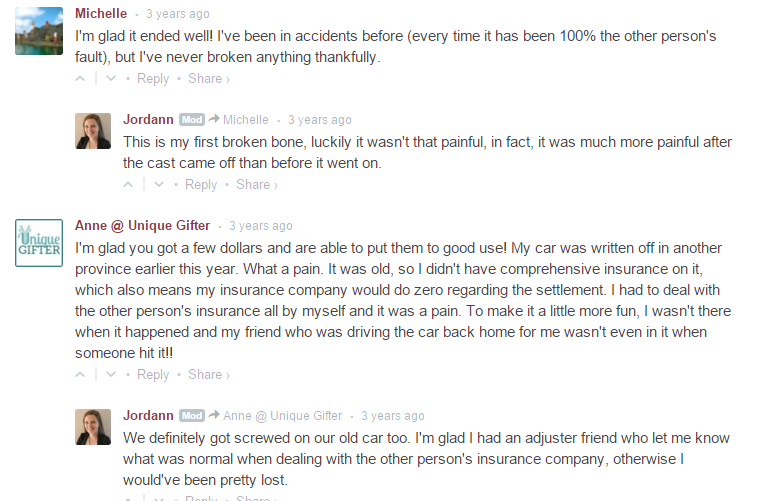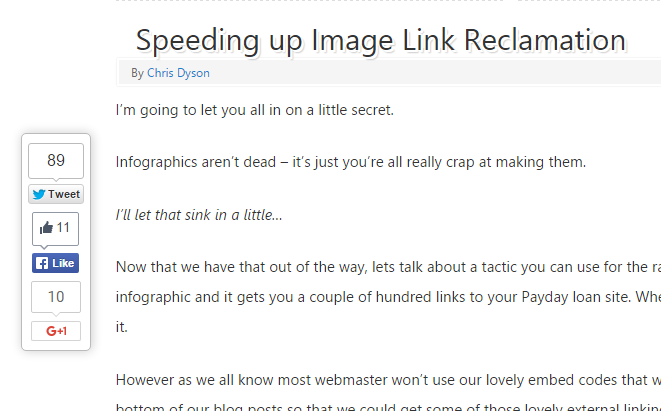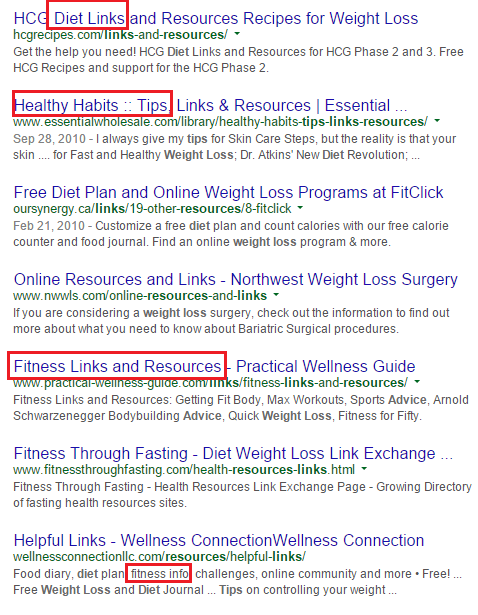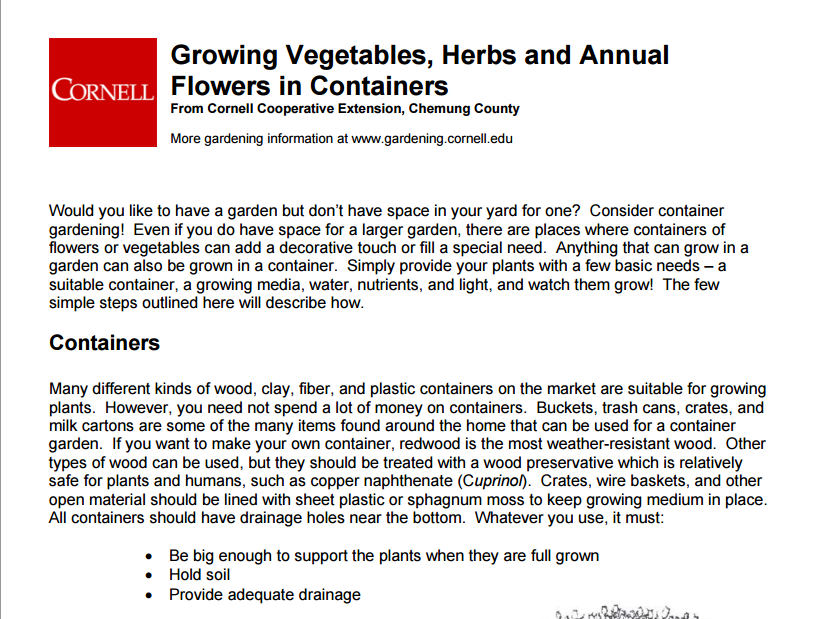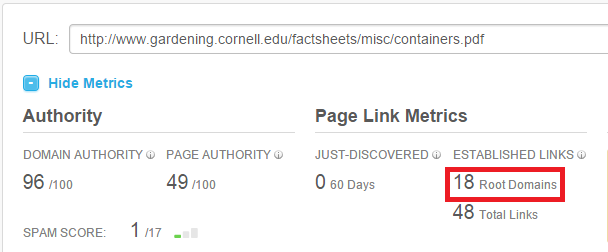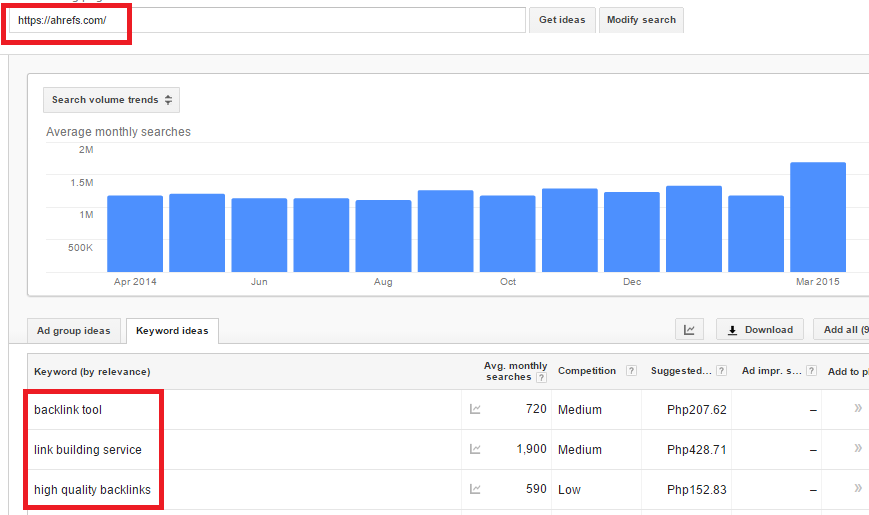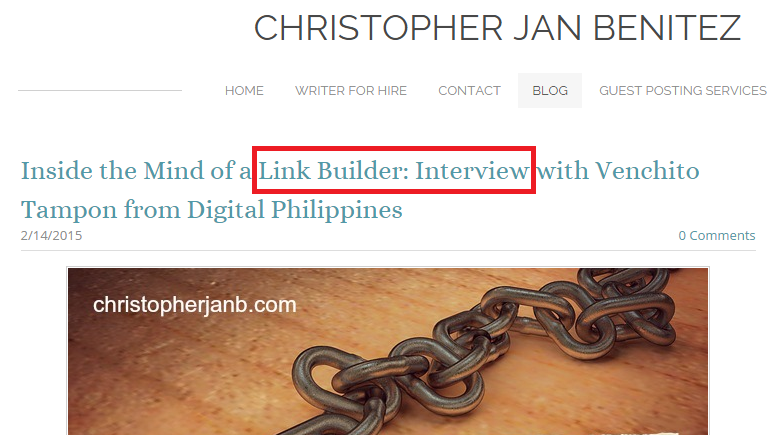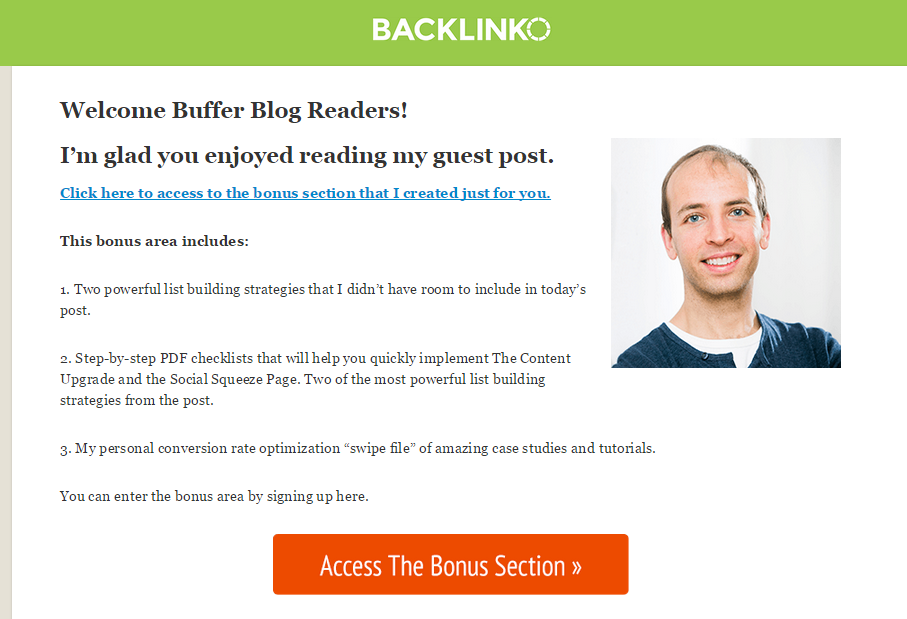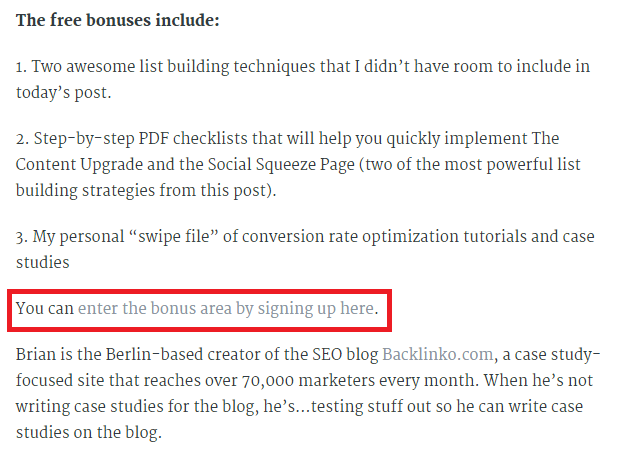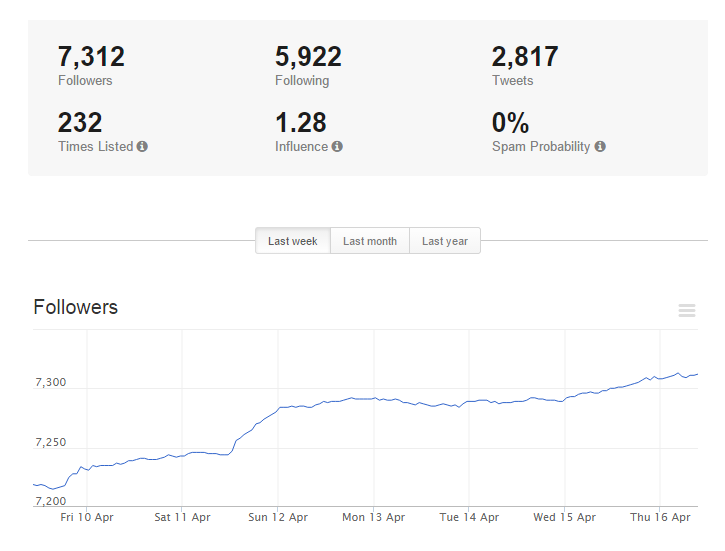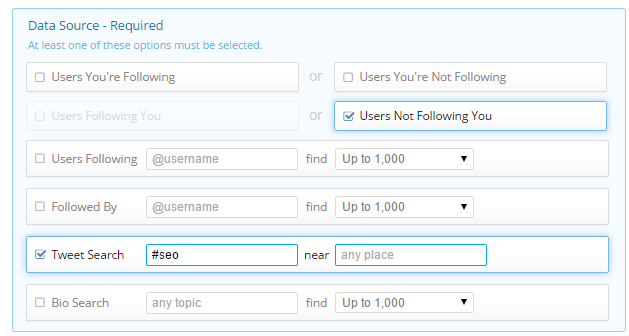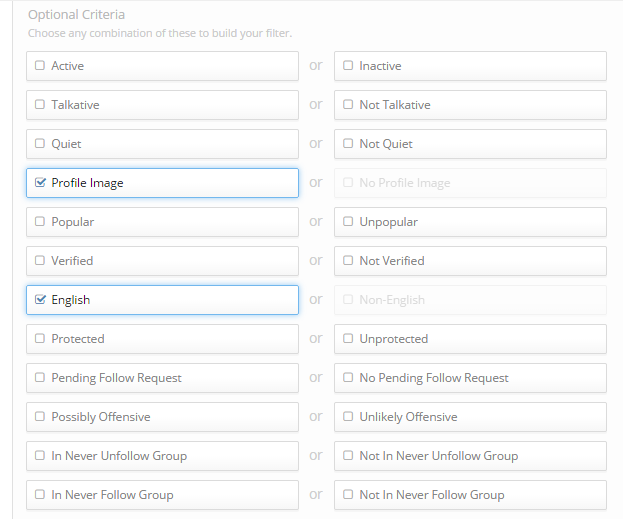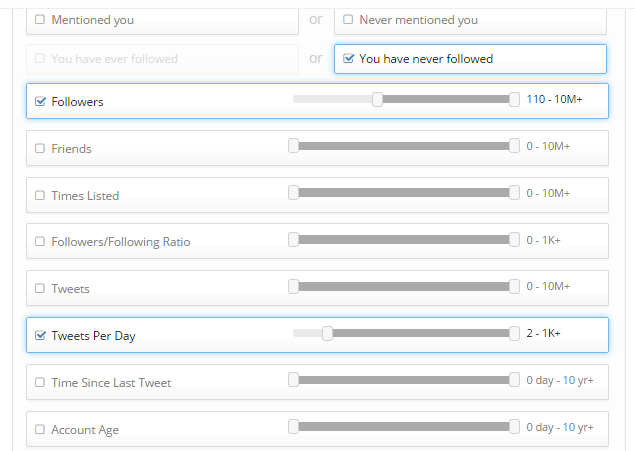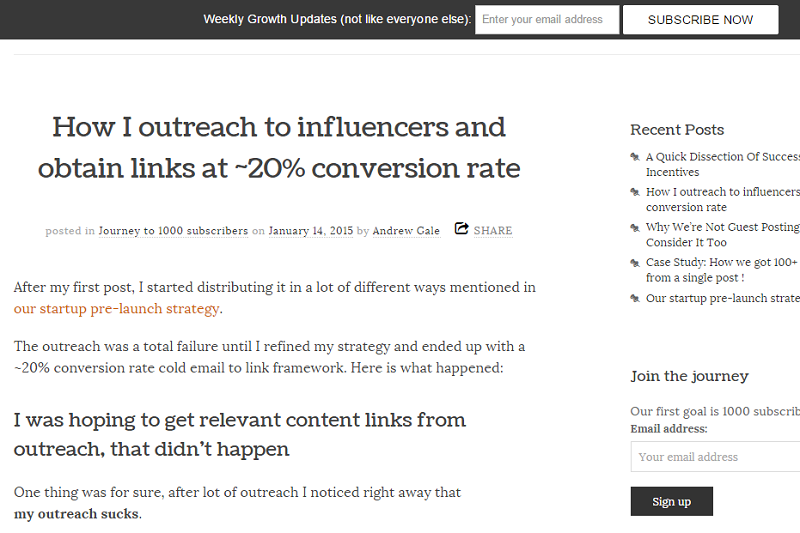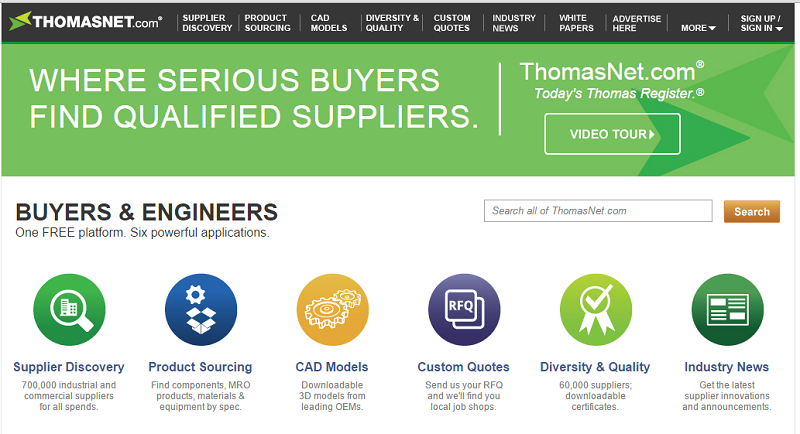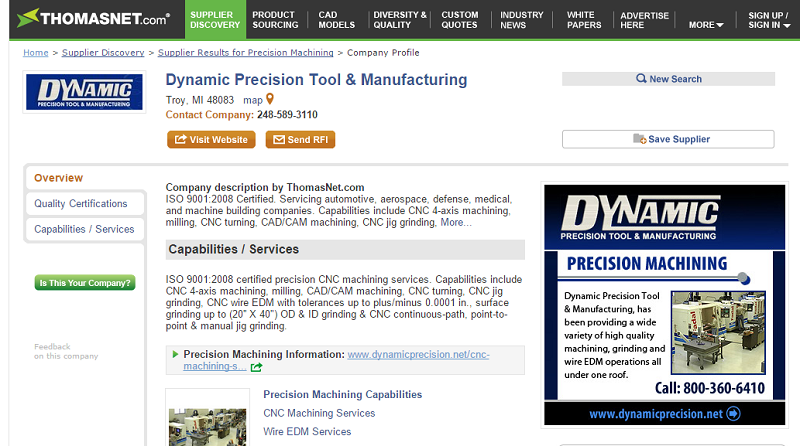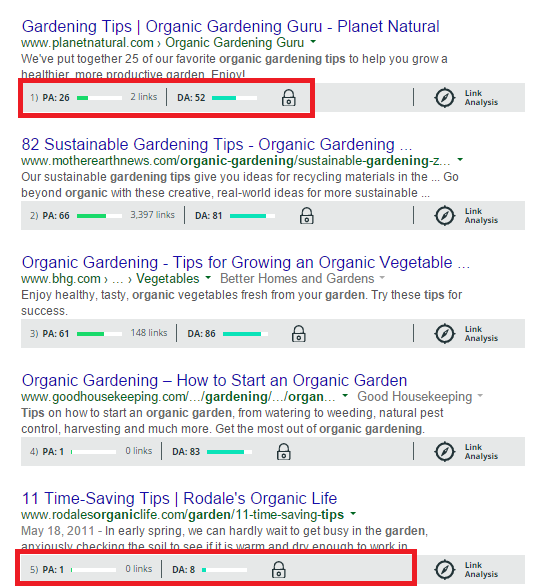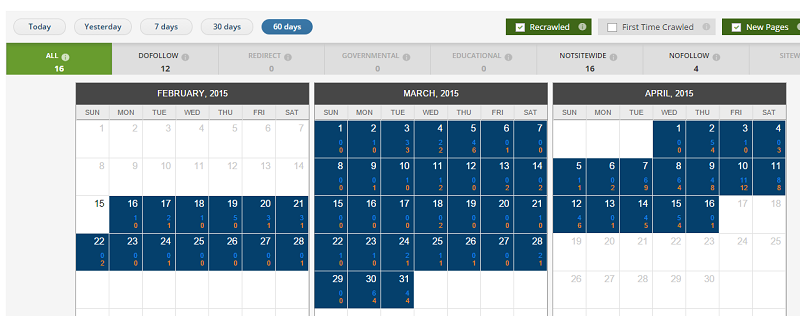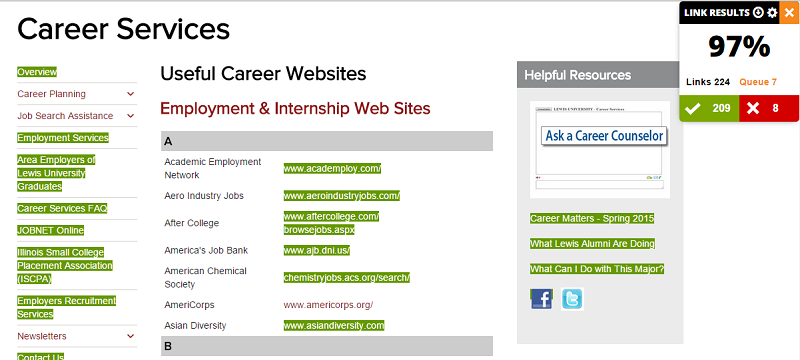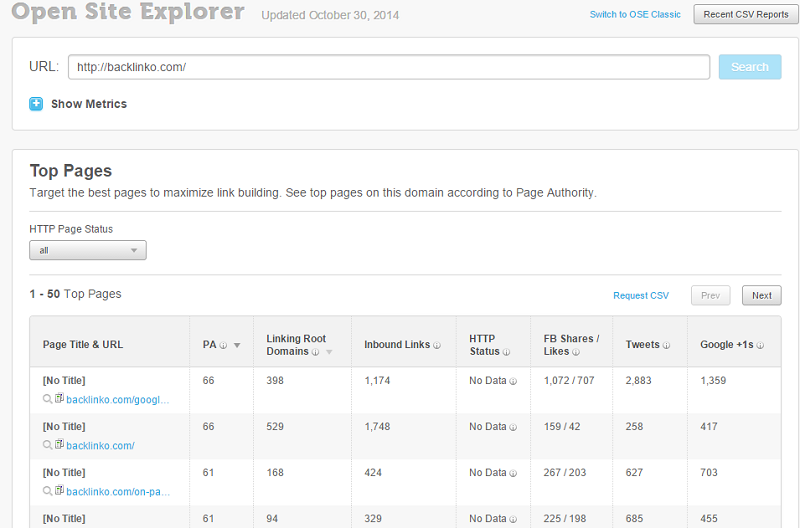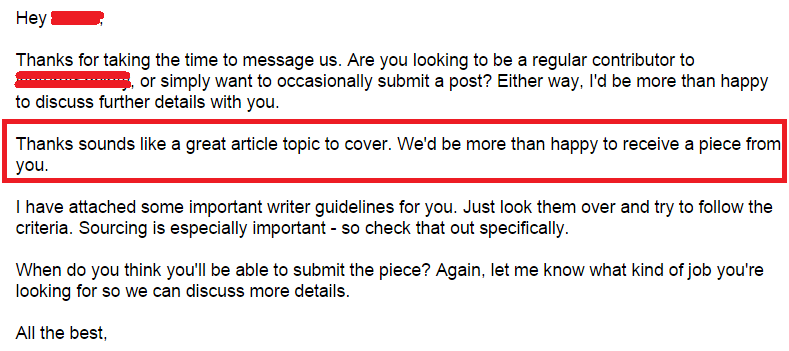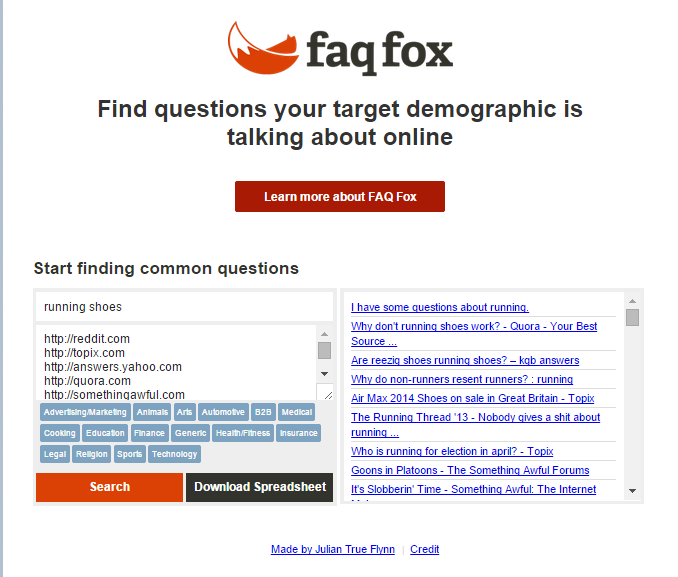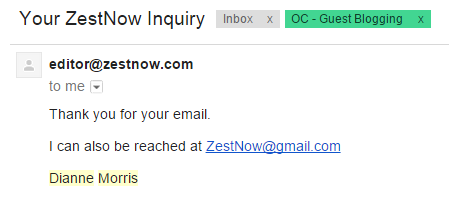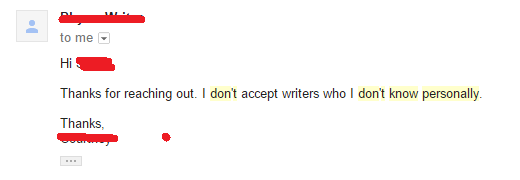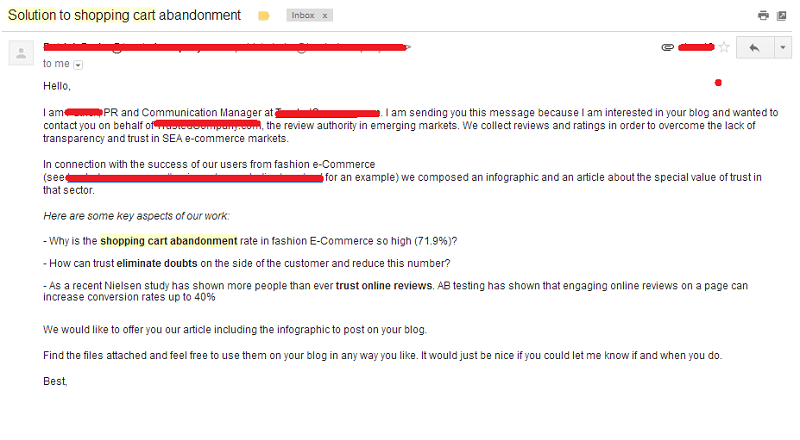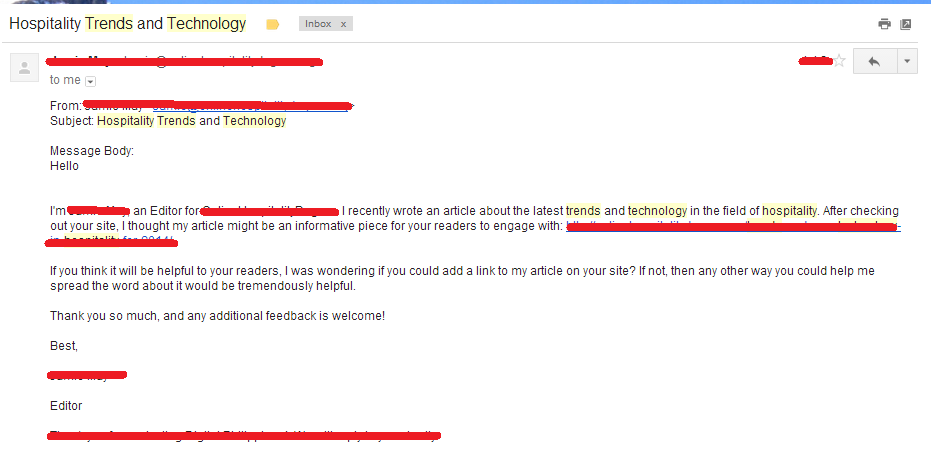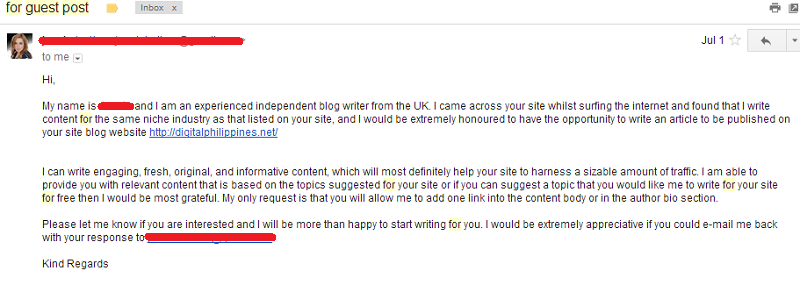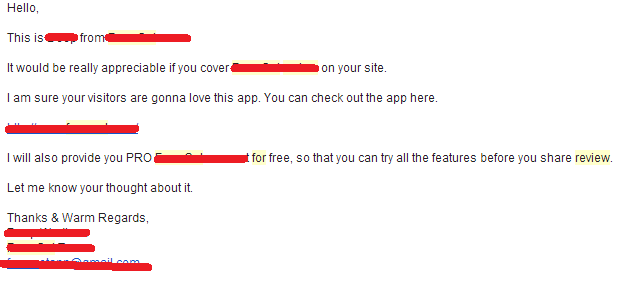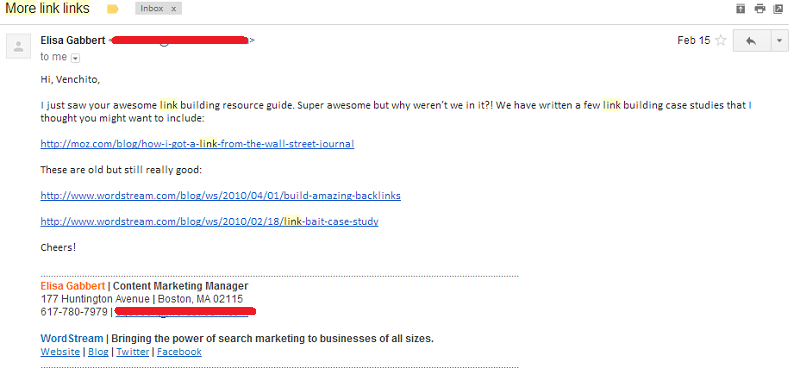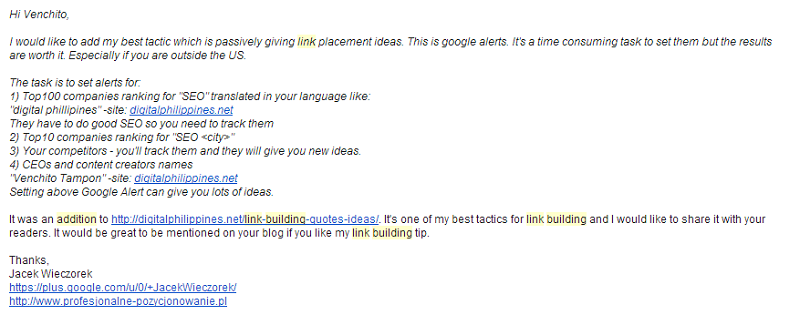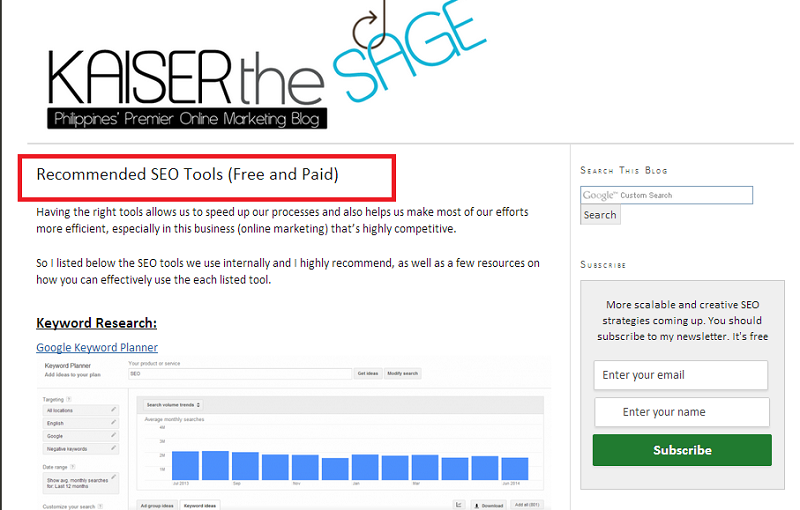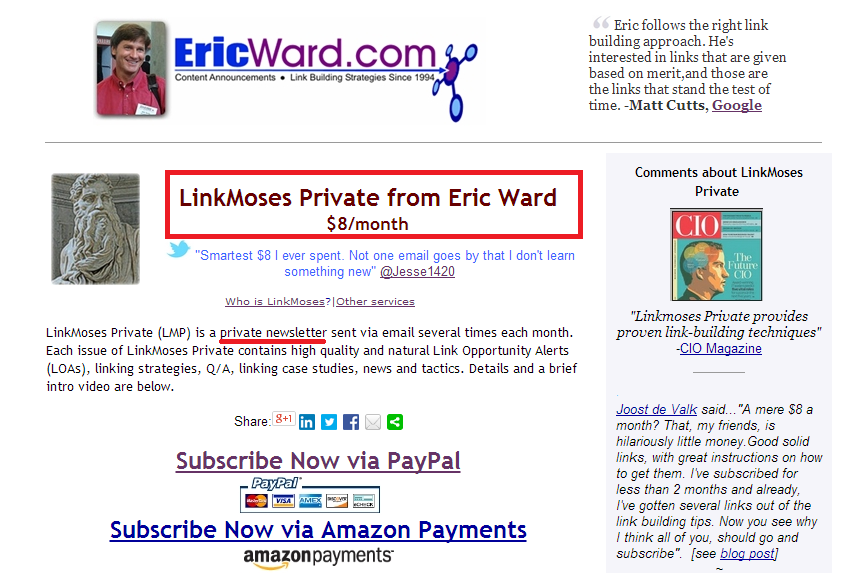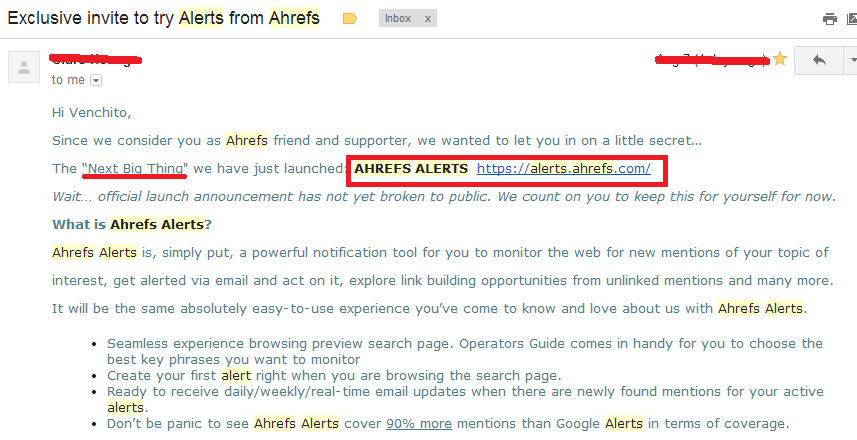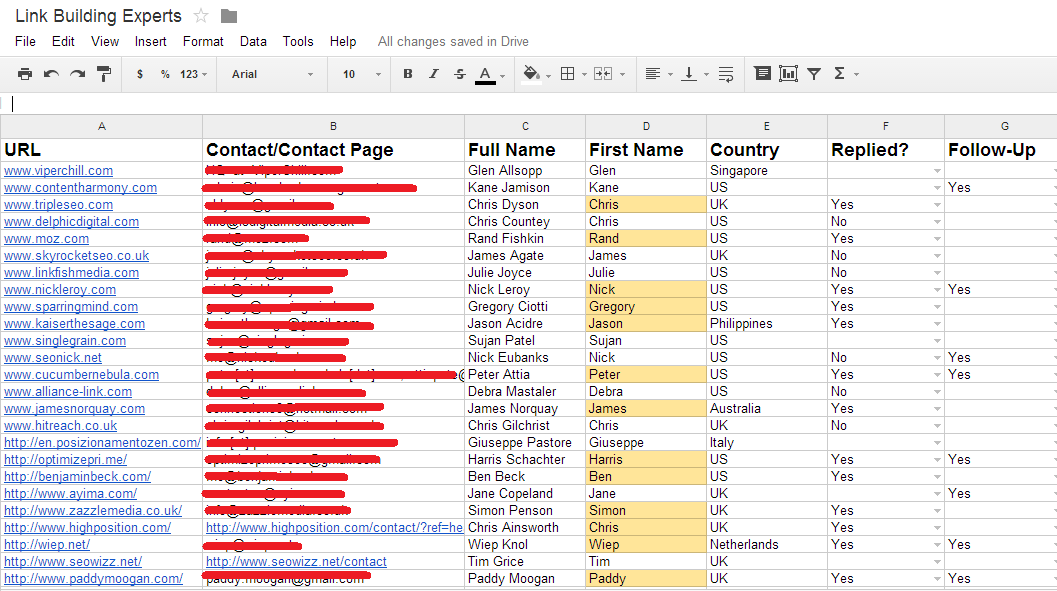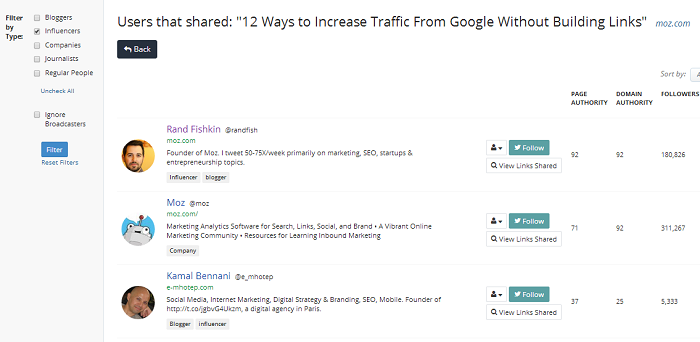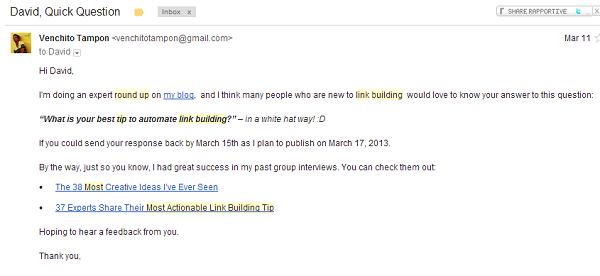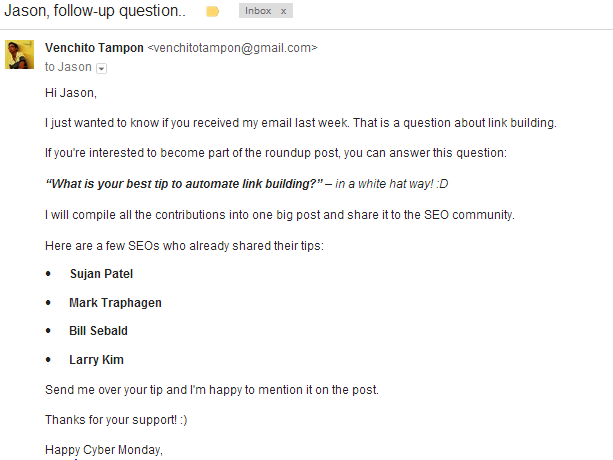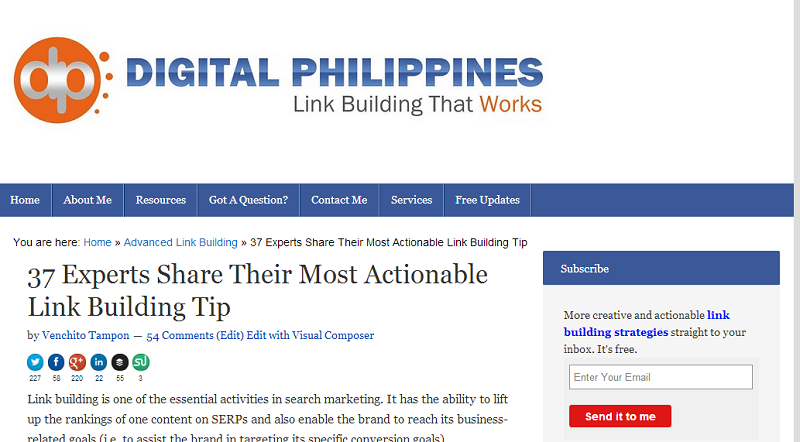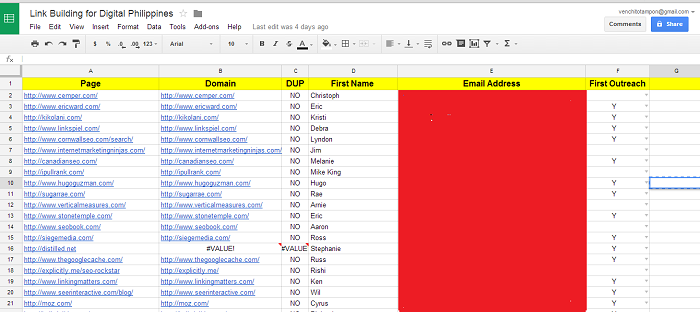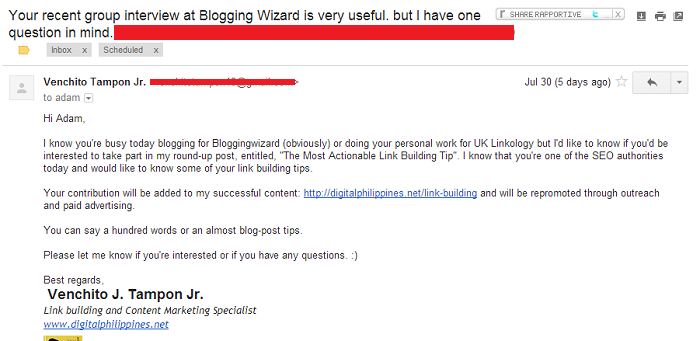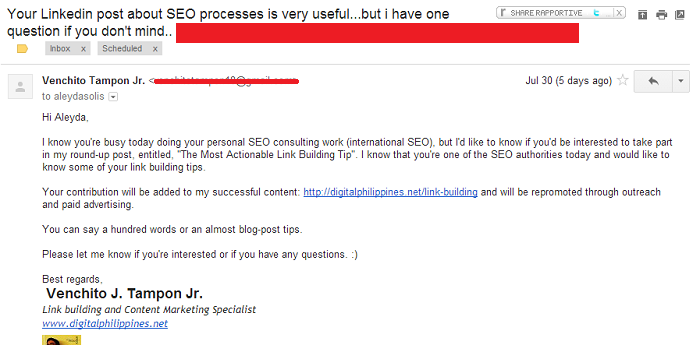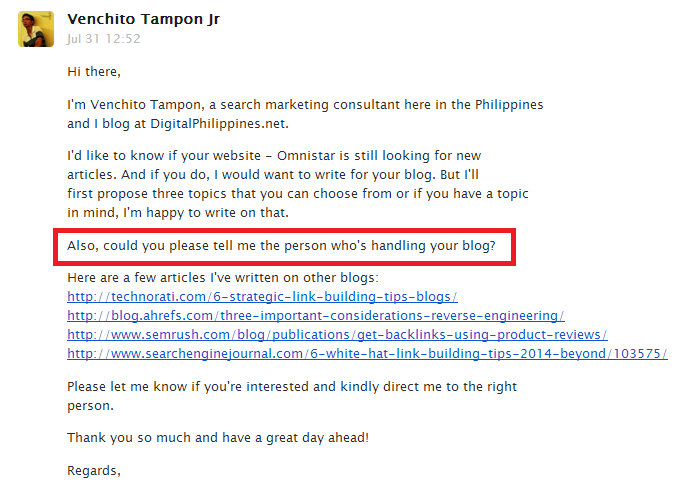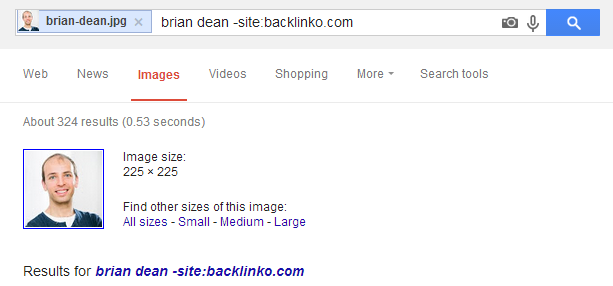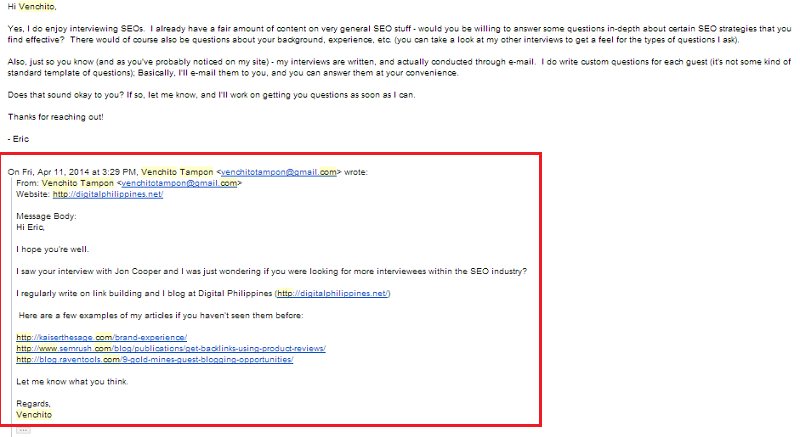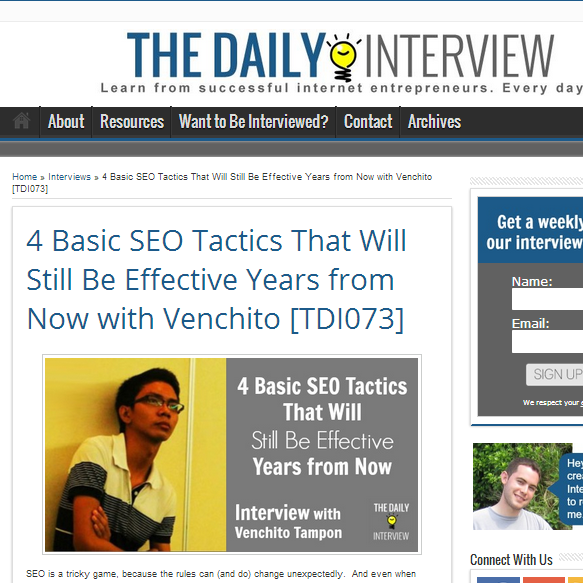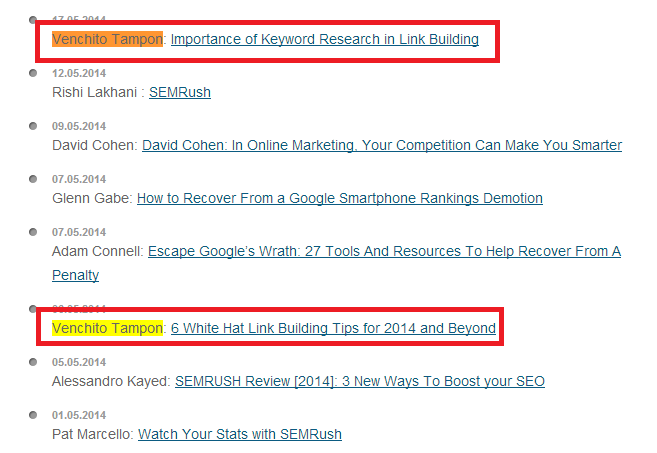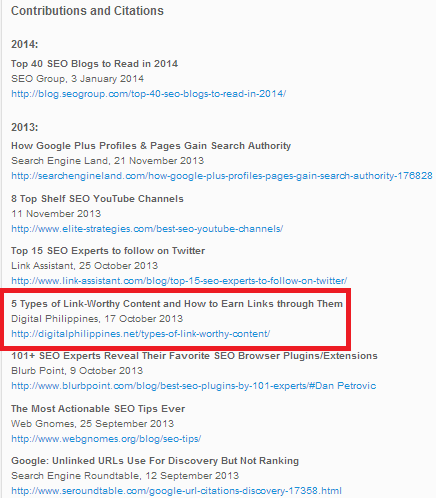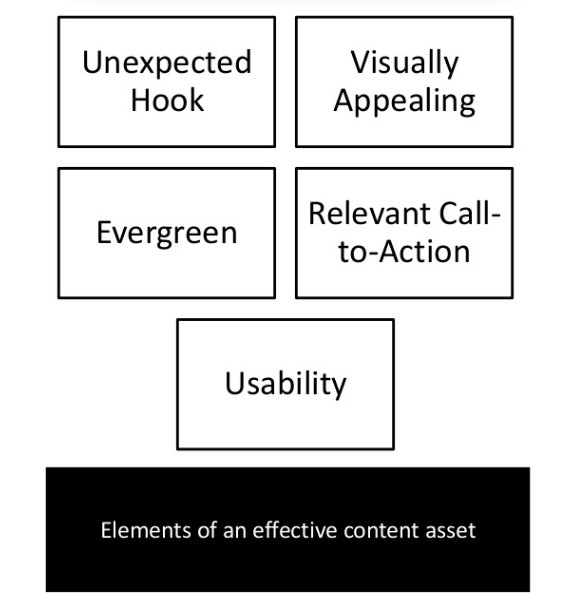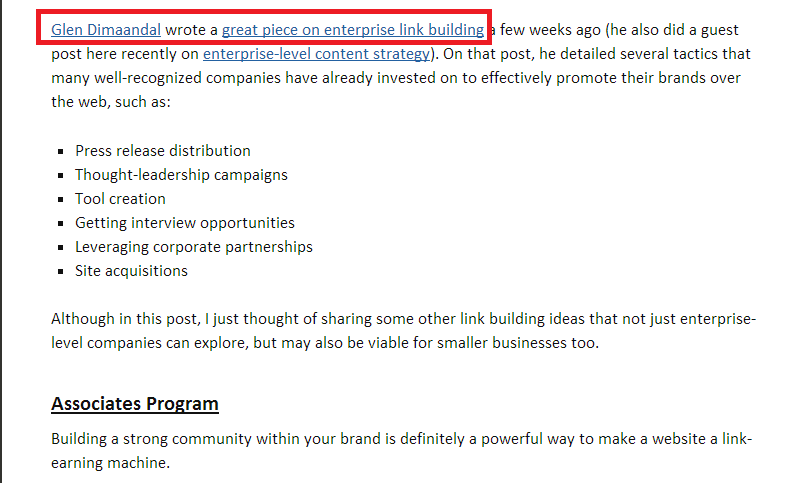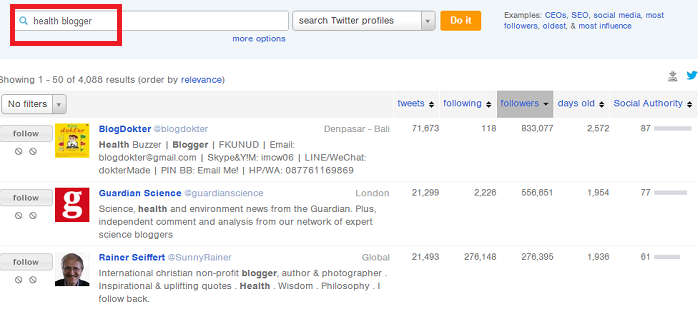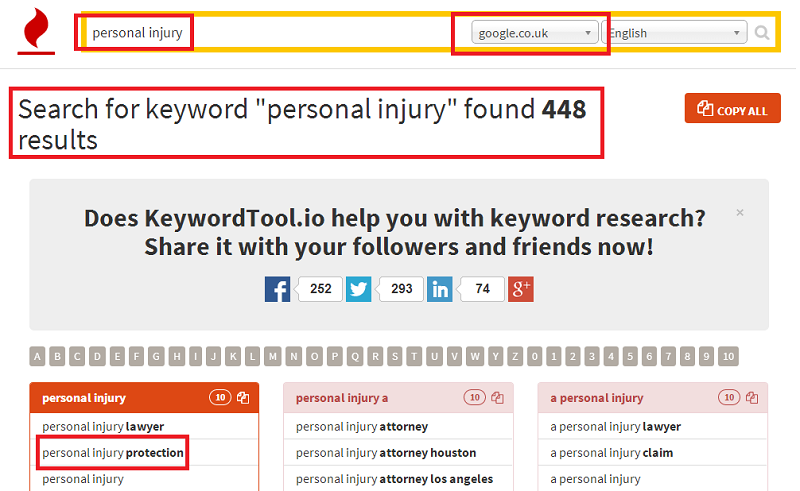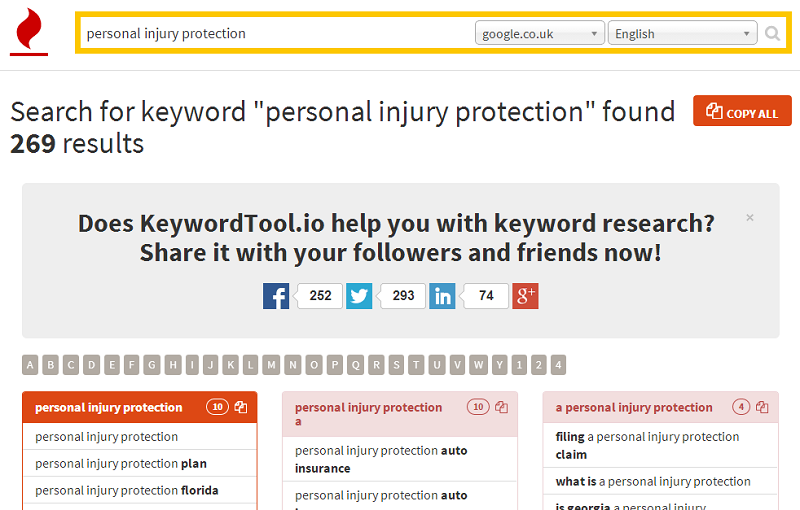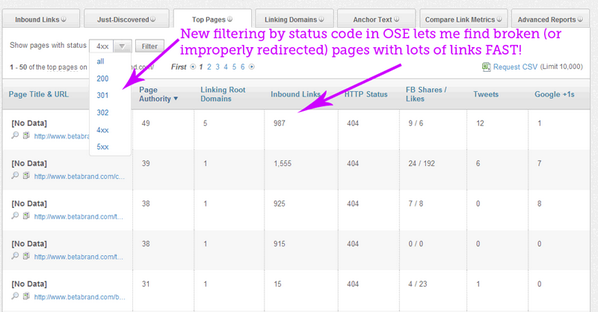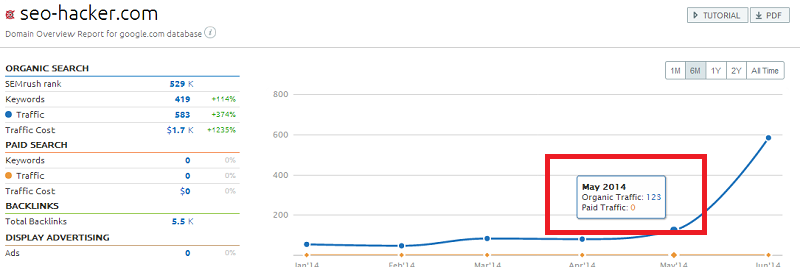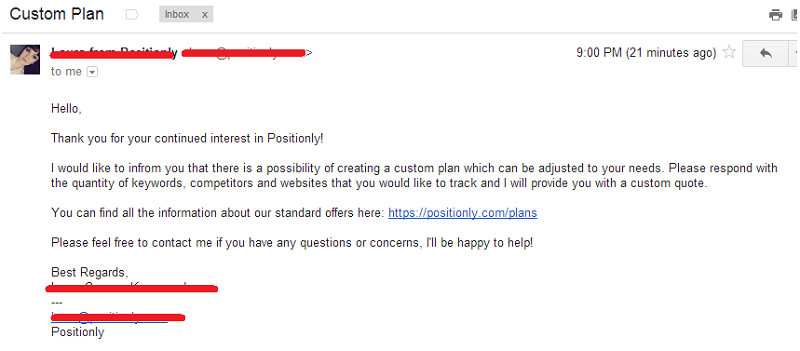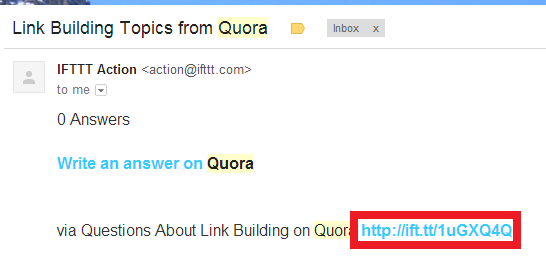Mastering Link Research Campaigns
Link research is perhaps the most critical phase in link building as this is where your initial link building efforts will come into play.
Building a long list of link opportunities requires the use of search engines, link prospecting tools (e.g. Ahrefs/OSE) and creative mind – as you have to think outside of the box in order to pop up new link research methods that are more effective than your previous ones.

This post is my presentation from last week’s MORCON (Master Online Rankings Conference) at Pampanga, Philippines, where different agency marketers, SEOs and managers had gathered to learn basic and advance strategies and tips on link acquisition, SEO and PPC.
Let’s get straight to the technical part of this post.
Advanced Search Operators
If you’re an advanced link builder, you are already familiar with common search operators (inurl and intitle) that filter page search results based on pages’ URLs and meta titles. This helps you prospect for pages closely related to your keyword and/or to content you’re likely to recommend to industry bloggers.
You may want to check out this guide on Google search operators, if you’re newbie in the industry.
These search operators (inurl and intitle) are commonly used in blogger outreach and resource page link building approaches.
But there are two search operators you may haven’t use for your link targeting campaigns or at least heard/read on other SEO and link building blogs.
Inanchor and tilde
Let me explain inanchor search operator first.
This search operator returns pages that have your target keyword as the anchor text.
In our internal research, we’ve found out that using inanchor search query may give a higher number of relevant pages than a simple inurl search query.
Here are some tactics where the inanchor search operator is highly useful.
Content contribution using inanchor
Finding niche blogs to target for content contribution is easy if you’re just working on a few campaigns but scaling it to around 10 or 15 or even more requires additional and effective link prospecting methods. That’s where inanchor search comes in.
Adding inanchor search operator to your current search phrases (write for us, become a contributor, submit a post, etc..) would help you gather new blog opportunities that aren’t discovered through inurl queries.
Ready to outreach opportunities
Response rate doesn’t only rely on how convincing your outreach templates and what details have you personalized for each specific link target, but in many cases, it depends on how ready the blogger/webmaster to respond to your pitch.
Inanchor search operator plus “contact me” allows you to find bloggers with high intent to respond to pitches. If you’re looking for quick blog prospecting, (e.g. 50 niche blogs in less than an hour), then maximizing the inanchor search is a good choice.
inanchor and inurl combination
Combining inanchor with other search operators gives you relevant link opportunities. For instance, you can use both inanchor and inurl search operators in one search phrase (see the image below).
Inanchor:”start your own blog” inurl links OR inurl:resources returns niche-specific resource pages with the blogging anchor text.
Link sourcing
If you plainly search for a target keyword/phrase with the inanchor search operator, you won’t get exact link prospects from the search results, but it would reveal new links pages of your competitors – which you can somehow consider for competitive link research analysis.
Head over to your favorite link building tool and look for pages/sites that are linked to resource pages of your competitors. Identify some footprints in URLs to initiate more link research phrases (useful-wordpress-links.html can turn to inurl:useful-wordpress-links.html).
inanchor and minus site combination
If you’re looking to build high quality links to your branded pages (about me/us, our team, press page, etc..) from interview and roundup pages, then getting straight to mining those opportunities is a good place to start.
Use inanchor search operator to find branded linking pages (best if you can indicate the name of the industry influencer to populate more search pages). Make sure you add a minus site search operator to remove pages of the influencer’s website from the search results.
Tilde
Tilde is a search operator used to find synonyms of a particular keyword.
Tilde (~) and Minus ( - ) Search Operator
Combining tilde with minus search operator can pop up new pages targeting synonyms of a keyword, but doesn’t have the exact target keyword. But with our internal research, using this search operators combination would give you the opposite – Google will still reveal pages that include the keyword even if you use the minus search operator.
Even if that’s the case, I’ve found out that tilde search brings pages that are laterally related to your niche.
A tilde search operator for blogging phrase would reveal sites/pages about web writing, communication and wordpress.
Resource inclusion for general bloggers
Tapping into other niches aside from your main industry is critical since you don’t want to go too far away from the root theme of your brand.
However, there are products or tools that could be targeted to general bloggers of almost every numbered industry.
If you own a Wordpress plugin, theme or hosting, then it is likely to be included in the recommended resources of travel, fashion, health, beauty and entrepreneur blogs.
You can use the search query, [recommended resources for NICHE bloggers ~guide] to find this type of links pages. Change the niche with the industry of your choice, and you’ll mine new link opportunities for your website.
Pro tip: If you have an affiliate program, then prioritize in outreach resource pages that have external affiliate links.
Tools
Tools speed up the process at some point, particularly when doing link research campaigns. They would help you to filter link opportunities based on set metrics as well as bring undiscovered link targets.
Here are two link prospecting tools you may want to check out for future research: Linkminer and Brandmentions.
This link building tool is mainly used for broken link building, its features are catered to resource pages, such as:
- Finding broken links (404s) on specific pages
- Seeing the number of external and internal links right on the search results (which minimizes the time you spend landing on pages with low linking potential). Pages with low to zero external links indicate that webmasters won’t consider linking to other references or resources.
If you want to effectively use Linkminer, you can check out this link building tutorial on PointblankSEO.
Mentions on the web, whether they are on forums, social or blogs, are proofs of your site’s branding, especially if they are actually earned.
Looking for those sites/blogs who recently mentioned your content (unlinked or linked) does help in analyzing the status level of your brand. Being top of the game means that you need to see which of your competitors are producing quality content (audience-targeted) and to identify new platforms where their content pieces are promoted.
Some cool benefits of using Brandmentions:
- Allows you to spot influencers using the topical mentions research, which helps your content ideation process run smoothly, as you are able to target the content to these influencers - which increases the shareability of your page.
- Notifies you of any mentions of your brand, staff member or page that you can leverage for relationship building – simply sending “thank you” messages to those who mentioned you makes a lot difference than pitching cold emails.
- Helps you compare the number of web and social mentions between your brand and your competitors.
https://blog.kissmetrics.com/influencer-outreach-in-content-marketing/
Metrics
Setting standards for your link development campaign helps you not only in filtering out low quality domains from your list but most importantly, in providing real value to your website or to your clients’ sites.
We're not using domain authority as our sole metric.
Let’s talk about some of the metrics that aren’t being used by link building firms today.
Engagement
What engagement does is that it validates the readership of a particular blog/site. The more engagement it receives (i.e. number of comments per post), the higher is the number of readers for each post (99% this is true).
When looking for blogs, try to set a benchmark for engagement. For instance, you would only want to consider blogs that have the average of 5 comments per post. This will help you ensure that you’ll absorb additional readers from the blog once you acquired a link from it (for newly contributed content).
Social Shares
Numbers don’t lie. The same is true with social shares.
Using social shares as one of your base metrics give you the assurance that there is a community ready to read your content, once it has been published on other blogs.
This also amplifies links to your content, as you can build additional links from bloggers who would have read your content or see your link and cite you as one of their references from their own blogs.
SEMRush Traffic
With Penguin 4.2 coming up at the end of this year, content creators and link developers should set organic traffic and link analysis as quality metrics/factors when performing link prospecting.
http://www.semrush.com/info/seedebtrun.com
SEMRush is a great tool of analyzing whether the site has been penalized in its recent years by simply looking at the organic traffic data (blue lines). Recovery that exceeds its latest drop should be considered, but those that have a steady downfall won’t be a good choice to add to your list.
One bonus tip… Create your own checklist
One of the agency hacks that will certainly develop your overall link building campaigns, which we’ve been using internally in our link building team is the use of checklist.
A checklist for every campaign removes inefficiencies in link research as well as it guarantees quality links in your lists. This is definitely you have to try for your company. Let me know in the comments if this works for you.
11 Off-page SEO Strategies to Get More Website Traffic
Off-page SEO doesn’t only revolve around links. Brand signals, co-citations and latent semantic indexing are a few concepts a search marketer has to deeply understand in order to maximize his/her efforts in implementing link buildings strategies for the campaign.
In this post, I’m going to show you 11 off page SEO strategies that can help speed up your link building process, boost your online rankings and get more website traffic from search engines.
1. Use LSI keywords as link phrases
We normally use LSI (latent semantic indexing) as a way to improve a page’s relevance to a specific search query – letting Google easily understand the page by means of looking at synonyms and connecting phrases/keywords.
So if the page is a review about “Cars”, the animated film, then there should be included words or names like “Pixar”, “Owel Wilson” and “McQueen”.
Further, aside from its relevance benefit, LSI keywords can also be used as phrases when finding link opportunities.
For the given example below, you’ll see that the phrase used is weight loss which if added to the advanced search query, will reveal some related industry terms like “wealth management tips” and “wealth reduction”.
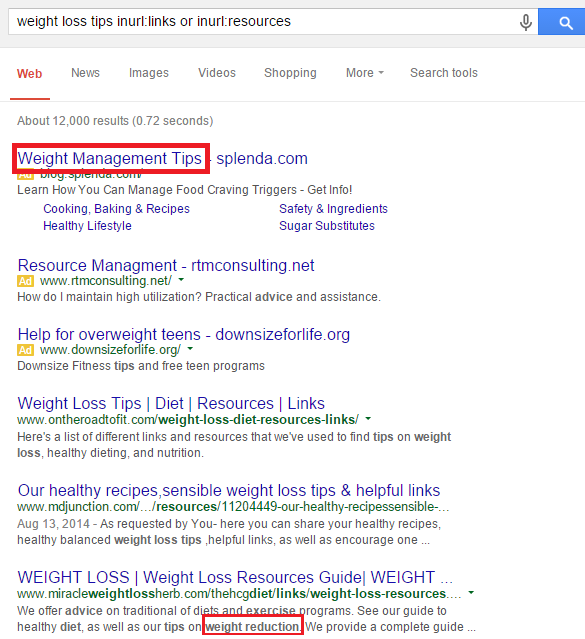
Add them to your common link prospecting terms - “wealth management tips” inurl:links OR inurl:resources, and go ahead find more backlink targets.
Another example is when you do a Google search for the phrase, “diet tips”.
Simply by observing you’ll see niche terms like “healthy habits”, “fitness links and resources” and “fitness info” – which are all included either in the ranking page’s meta title or meta description.
Become more observant at niche-specific keywords as they can open up hundreds of link opportunities by doing a Google search for them.
2. Convert highly useful PDFs to accessible pages
Research papers and data-backed documents are mostly designed in a portable document format (PDF).
These pieces are crafted with excellence and accuracy, but what’s missing is that not all of them are accessible to the public (keep aside those confidential company pages).
What you can do is to convert these highly useful PDF documents into one accessible page.
I suggest you find three or four of this type, compile all information into one page (make sure all details are interrelated with each other), then publish it on your blog.
To find PDFs related to your industry, you can use the advanced search query: filetype:pdf, plus your industry keyword .
Below is an example of a pdf file that is discovered by searching for “gardening tips” on Google.
As you can, the document has 18 root domains, which if added to other documents’ link targets would probably summed up to 40 or 50 backlink opportunities.
You can reach out to these potential linkers and simply share your accessible page. Conversion rate would be much higher because of the utility and packed information of the content.
3. Improve relevance with keyword integration to brand
Helping search engines understand what your brand is all about and the purpose of each of your pages could pull up your rankings both for commercial and non-commercial pages as well as easily increase brand recall within your community – as users can know your brand based on your website’s context (which is a very effective off-page SEO strategy).
See how big G understands Ahrefs. Though a lot of the keywords in the image below are not aligned to what their products are offering, still brand recall is evident.
Ahrefs penetrated into a specific and competitive sub-niche (link building) where its customers are taking place.
Here are a few tips on how you can increase brand recall for your website and integrate desired keywords with content distribution efforts:
- Write descriptive author bios that particularly gives emphasis on what your brand is capable of providing for (either it is a service, resource or message).
- When asked to answer interview questions, suggest titles that will best describe your brand and your staff member in order to add up recall to your company.
- Invest in building expertly-made content for your website in order to attract recognition and interview opportunities – where you can somehow control the context of the page.
- Participate in online forums and target only one sub-industry. Answer questions based on brand’s experience and try to include case studies that’ll provide value to thread participants.
Keyword integration to brand promotion will certainly take time but what’s mainly important is to get big G understand the brand in the right context – where ranking keywords will help generate sales for the business.
4. Create targeted landing pages for external web properties to increase click through
Landing pages that are crafted with benefit-driven content and powerful copywriting skills will not just drive potential customers to the brand but possible linkers from the community.
One good example of a targeted landing page is this bonus content from Backlinko, which can be seen if you click on the link below Brian Dean’s guest post on Bufferapp blog.
This idea isn’t new for savvy marketers, but when done regularly for external web content (i.e. regular columns), it will impact the domain’s referral traffic data – since visitors are much more likely willing to visit the site when there’s an added value offered beforehand.
You can check out this post on 25 landing page best practices.
5. Boost social following with Manage Flitter
Social signals are off-site SEO signals that strongly indicates a site’s user activity or behavior which can help its page(s) rank higher in search results with a minimum requirement for links.
One of the main techniques that I’m implementing these days for my social campaign is a robust following/unfollowing activity.
To speed up the process, I use ManageFlitter, a social media marketing tool that generates data on a daily, weekly or monthly basis (example image below).
My normal approach is following a certain number of social users every single day then unfollowing those people who haven't followed me within two or three days.
Note: Please read the Twitter guidelines to avoid any chances of getting suspended.
Here are my basic requirements of a targeted social user:
- Users not following me (you)
- Twitter search (#seo) – at least once in their tweets, they included the hashtag “#seo”
- Profile image
- English (tweets and profile must be in English)
- I (you) have never followed
- More than 100 followers
- Has an average of 2 tweets per day
The tool will charge you $12/month for 5 social accounts.
The good thing with this automated tool is that you can scale the social activity - even spending 5 minutes/day. This will certainly boost your social presence and bring in referral visits to your website once you start sharing useful content.
6. Build authentic and personal relationships with industry folks
Earning authority backlinks today is almost impossible without having real relationships with industry publishers and content creators.
Relationship building is a tedious activity that requires a balance of time and planned action. Investing too much time with influencers who can’t give benefits to your brand – as they may not be interested to the value you are offering is probably a waste of time.
On the other hand, expecting a relationship to immediately yield results would get others pissed off and would produce bad impression about your brand.
Andrew Gale wrote a very interesting case study on how he managed to get 20% conversion rate in outreach by offering unique value to each prospect.
Here is a short recap of his outreach process:
- Pre-engage outreach targets by sharing their latest content on social, participating in conversations where it is relevant and understanding deeply their interests as influencers/bloggers.
- Personalize your email with enough boosting of their egos – could be more effective if you praise one of their posts.
- Show that you appreciate their post and elaborate how your post is going to make theirs even better.
- Offer or give something for free (value/ego boost)
7. Get cited links from supplier websites
Profitable links should be best placed in websites where customers are engaging and have high purchasing power.
If you are a supplier of any product from any niche, then getting backlinks from general supplier sites would help customers to directly find your brand.
You can create a profile in Thomasnet, add a link pointing to your company site, complete all the information and earn some referral traffic once your page has been published.
Here’s a sample of a company page that has all the necessary information – from logos to types of services offered.
8. Identify ranking potential through link analysis
Improving pages’ rankings in search results and building importance across your industry are a few goals that a link acquisition campaign should at least achieve in long term.
One of the effective methods in determining if there’s a ranking potential in a particular keyword or set of keywords is by looking at the average number of referring domains for each page listed in SERPs.
For instance, the keyword phrase, “gardening tips” has thousands of monthly searches, so when you do a Google search for it, you’ll see authoritative domains outranking the less popular sites in the gardening industry.
If you have a new website, you can compete with these bigger brands by publishing a content asset that is optimized for the phrase, “gardening tips”.
Instead, you might want to go to another route – that is finding other keyword phrases that don’t only have low competition level but wherein you’ll have high chances of ranking based on link analysis.
Basically, link analysis could help you estimate the average number of backlinks that you have to build for your page/site in order to get to the top 5 of page 1 for the target keyword, “organic gardening tips”.
The first domain ranking for that phrase is a list post from Listolic. Currently, the page has 68 referring domains with 16 new links for the last 2 months.
This means that the benchmark or average number of links that you have to build should be around 70 in order to outrank its existing links plus incoming links acquired each month.
Do the average math for the five ranking pages in SERPs and identify what number you have to achieve when building links for your content/domain.
From that average number of referring domains (let’s say 40), you would want to find evidence of at least ~400 resource page type opportunities that high potentials of linking to your site (assuming you could convert at around 10%).
You can check out this in-depth guide by Nick Eubanks on the subject of ranking potential.
9. Acquire image links by inviting guest contributors
In my first several months of blogging, one of my main struggles is blogging frequency – that is publishing articles consistently on your blog without any chance of breaking the momentum.
Achieving it won’t be possible if you don’t invite other industry publishers for your blog. But with that sole purpose (follow blog frequency), I’ve found that there is a higher chance of earning links by inviting guest contributors rather than creating content all the time by myself.
One backlink that I earned several months ago is this image link from the homepage of PageonePower.
This isn’t an ordinary image backlink since it demonstrates authority – notice that keyphrase “where we’re published”. It adds value to the backlink given that visitors of that site would find that my link building blog is an authoritative publication in the search space.
Here are some actionable tips on how this off-page SEO technique will help you acquire authoritative backlinks:
- Collect data of industry friends that have an engagement history with your brand as they are more receptive to invitations since they knew about your website and you as a publisher. A few months ago, I’ve been receiving a lot of guest content contributions from my local industry peers, primarily because I’ve been active in speaking at local SEO seminars here in the Philippines.
- Add a monetary benefit to their guest contributions – both one-off payment and additional price once their post gets traction on the web (i.e. if they reach 1000 visits in one week). This technique would motivate them to create content that are highly useful and can potentially attract new incoming links.
10. Move the ladder by pointing out specific pages for broken links
Broken link building isn’t new to many folks reading this post today.
However, improvements in implementing this off-page SEO strategy should be the number one priority of every link building team.
One way to move the ladder is to point out the right pages that a resource page should be linking to.
Start with finding broken links in the page (use Jon’s LinkMiner – it’s updated regularly and my most recommended Chrome extension tool).
When you collect all the data such as broken URLs and anchor texts, try to understand why these links are broken. Search for the correct links and include them to your outreach.
For example, this career resource page has 8 broken links, found using the LinkMiner tool. One broken links should be directed to http://careers.npo.net/ and one is 404 page, which if investigated is in a development stage for a redesign.
In your second conversation with the potential linker, you can use those details as an added value to your outreach.
Here are the ones I encountered in this page: http://www.lewisu.edu/resources/careerservices/careerhelp.htm
- npo.net/jobservice - the company has a new website http://careers.npo.net/
- internsearch.com/ - the site is currently under redesign
This approach will take a few minutes of your time but can highly increase your conversion rate because you’re giving value as opposed to just emailing them broken links in their resource page.
11. Use Launchrock to build initial trust signals for new websites
Most of the time, new websites don’t have initial traction in the community leaving it impossible to acquire its first set of blog readers, email subscribers and/or potential customers.
However, one of the ways to build some initial traction is to use Launchrock. It is a site builder platform that can help you create one landing page (may it be the homepage) for your website.
A few tips to maximize launch campaign for new websites:
- Build contextual backlinks from industry-related blogs by contributing useful content that can bring referral traffic to the landing page – helps your brand to acquire its first set of email subscribers.
- Engage in niche-specific forums to create alliances with industry peers who’ll eventually help your domain earn its first tier of backlinks.
If you are looking for a link building agency to partner with you, then don't hesitate to contact us today.
11 Outreach Best Practices That You Can Easily Apply To Your Blog
Great outreach always lands coverage. Whether or not it is accompanied by a link/mention, the potential business value that coverage can provide to your brand is still worth your investment.
Best practices in outreach are not products of great inputs by experts in the blogging/internet marketing scene but rather just a collection of small pieces that improve a specific outreach in order to yield great results (higher response and press/link coverage rates).
In this post, I’d like to share a few outstanding outreach practices that you can immediately apply to your blog.
1. Using corporate emails with branded signatures for commercial sites
I’ve seen a large percentage of outreach emails fail even before the battle begins because of one simple reason – not using corporate email for the initial and subsequent pitches.
Using a corporate email for outreach doesn’t only make your pitch professional, but would also make it easy for your prospect to contact you via your website’s contact form, in case they will offer content partnerships or other brand-related opportunities.
Uniqueness adds more chances of getting your pitch remembered by your link targets. Instead of a common gmail account, your prospects would see a unique domain that might help them decide if your pitch deserves a response. Domain names that include industry related phrases can get more attention from recipients than domains without semantic relevancy in their brand names.
For instance, you can easily determine that this working shoes site is a working shoes brand because of its brand name. So when this particular business asks for a specific link or partnership, the link target can quickly understand the nature of its business, which will be his/her deciding factor when trying to respond to the pitch.
In this actionable post by Ross Hudgens on SiegeMedia about using PR practices for link development campaigns, he emphasizes the value of using branded signatures for outreach.
Some significant points from the post about the importance of using a branded signature when pitching bloggers/journalists in the field:
- Increases the credibility of the pitch.
- Adds a differential factor against other outreach emails (because you make your brand’s phone number visible in your first email).
- Higher friction of earning a response/contact via direct email or phone.
Here’s an example of a branded signature.
It’s easy to add default signature to your email. Go to your email provider settings and insert these specific details to your signature:
- Name
- Company position
- Company name (linking to your website)
- Logo
- Phone number
This action tip is pretty basic for advanced link developers out there, but if this is done correctly, this could really make a big difference to your campaign’s result.
2. Using top pages to identify link target’s interest
Identifying interest of a certain business/site is one of the underrated techniques to secure positive responses from niche bloggers/journalists. Knowing what idea, strategy or topic he/she is interested to discuss with you can help improve your pitch and make it beneficial to your prospects.
There are so many ways to determine what a specific website/blogger’s interest is. One of them is using Open Site Explorer to track the top pages of a certain website, which is commonly based on the page’s performance in terms of authority and # of referring domains. The tool is indeed useful when scaling this outreach approach – identifying link target’s interest.
Why ranking pages is a good identifiable factor of a link prospect’s interest?
- Efforts devoted by a person can result to higher performance of the page, which means that if someone is very interested with the content he produced, he would promote the page to increase its page discovery (leading to a good link and social performance). Removing important pages like homepage and branded pages – about us, our team, etc.., this assumption is probably true.
- Pages that get a lot of traction in the community can be sources of highly useful/acceptable content ideas.
Inserting prospect’s interest in your email is a good technique to spark some interesting conversations with your target.
3. Pitching unique ideas not yet discussed in a blog’s existing archives
Sending two or three content ideas to write about for a specific blog is one of the common strategies outreach specialists/marketing managers are using to get the attention of blog editors.
This guest blogging approach could still be improved by adding creativity to the content ideation process – pitching only unique blog topics.
These are just a few examples of how this approach can result to positive responses from bloggers.
This is very much applicable for contributors who don’t have any writing samples to include in their pitch in order to prove their capability of writing great content. By pitching unique ideas, you’ll be able to show how knowledgeable you are in your industry and how interesting your piece would be even you haven’t started writing it.
One of the content ideation tools I’m very much amazed and is part of my SEO arsenal today is FAQFox. What it does is that it allows you to see a list of questions people are asking in your community related to the keyword/phrase you inserted in its search box.
If you’re working on a new content marketing campaign, FAQFox can provide you several topics that might not yet been discussed on your target guest blogs. Including those topics to your pitch could make some difference to your campaign’s response and link acquisition rates.
4. Pursuing commitment to earn trust
The hardest part in outreach is not finding the contact emails of your target bloggers or journalists nor scheduling emails in your CRM tool but actually building the right relationships and earning trusts from your potential amplifiers.
Effective relationship building doesn't only break relationship barriers between you and your amplifier but allows both parties to benefit from the partnership you both actually agreed on.
There are many ways to strengthen relationships but one of the most valuable methods is initiating commitment to a specific task. This approach is doable in many simple actions (that you can also insert to your pitch). A few of them are:
- Helping a blogger lighten his blogging workload by applying to become a regular blog contributor, especially in busy seasons like Christmas.
- Committing yourself to send any future error pages that you might encounter in a links/resource pages (assuming you’re executing a broken link building technique).
- Sharing someone’s content works on social and blog communities without asking for any incentives from that person. You can also use this commitment as your initial sentence to your pitch (i.e. I’ve been a social follower of your blog and shared your recent posts on [topic 1] and [topic 2].
Though commitment will always require time and effort, and it seems that this can’t be done in a scalable manner, the fruits of doing so would be much higher than plain engagements with your target influencers/bloggers.
5. Improving subsequent pitches by analyzing unsuccessful emails
There are tons of reasons why your email didn’t get a response (that you can somehow track using your CRM tool). Below are some of those reasons:
- Pitch sent at non-peak hours of the recipient (burying down the email to the bottom part of the inbox).
- Non-related pitch (wrong choice of potential amplifier).
- Inactive or non-validated email.
- Low interest to respond to the email (email may not be straightforward or beneficial for the receiver).
Knowing those reasons should push you to take actions to increase response and coverage rates in your next round of pitch. Those actions include:
- Perform necessary actions to directly connect with your recipient in case you don’t get a response (they could be in the form of blog commenting or social engagement).
- Find secondary emails and note them in your spreadsheet (look for non-generic emails like name@domain.com; don’t be satisfied with info@domain.com and other common types of emails).
- Go back to auto-responder emails. They may include other contact points that you can utilize for second pitch.
6. Personalizing pitch based on industry’s needs
Personalization always comes to play when outreach/content promotion is being discussed on blogs and communities. But what most personalization in outreach lacks is including details that best describe the needs of the community.
Notable tips to consider in persona outreach:
- Get insights from existing industry articles and determine the most common pain points in the industry (e.g. relationship building with family members in the parenting niche). Semantically improve your pitch by adding those insights to your pitch, in order to emphasize the need to respond to your email.
- Utilizing information found on a specific website to focus the pitch on your content’s benefit. For instance, blogger outreach specifically designed for scholarship page promotion should note the range of budget and list of expenses the scholarship will cover (e.g. laboratory expenses for medical students).
- Change opening and closing remarks in email (e.g. Happy parenting! for parenting bloggers).
7. Engaging early before performing initial outreach
Adding personal touch to pitch is good enough for mediocre outreach campaigns. However, if you are targeting high-tier blogs and news sites, you have to execute pre-engagement activities to tap signals to your target content amplifiers.
You don’t want to receive this kind of email, right?
Actionable tips to perform pre-outreach engagement activities:
- Follow blogs you’d like to reach out to and share their recent blog posts on social and blog communities.
- Authentically comment on targets’ recent blog posts (you can use RSS feeds to track their future articles). Let them remember you by adding value to your comments.
- Include your blogs’ high quality articles to your own content. Let them know about it via email/social even before you connect to them for your main pitch.
- Subscribe to their newsletter and learn the latest updates about their brand and its industry.
Pre-outreach engagement initiates relationship building right from the start of your outreach campaign, which makes it easy for both parties to know each other and help you identify what would best work in your pitch.
8. Writing more on benefits rather than descriptions
If you’re doing PR for quite some time now, one of your must-do acts is writing email copies that are saleable to journalists who are looking for new stories to cover in their news sites.
This sales approach in outreach is also applicable to other outreach campaigns like content contribution or link requests wherein they require solid lines of benefits to persuade someone to give a link to a certain blog whether or not there is an intention to have one.
Now, here are some tips to make your pitch benefit-focused:
- Get straight to the unique value proposition of your content (if it is a direct product, then doing so is very vital to your success). Emphasize content’s UVP in the first few lines of your email.
- For content contribution, some authority blogs require bullet points of subtopics that you want to discuss in the article not just the list of suggested topics/titles. In this case, adding benefits or points to your pitch would be a better option rather than just listing down suggested ideas that you want them to choose from.
- For content aimed at getting links from industry-related blogs, you might consider adding a few lines in your pitch detailing which sections/paragraph in the post you would want to be mentioned. Provide reasons why it would be a great fit to add as a resource to their article.
It is very important to understand the worth of your content before promoting it to your target audience. Confidence in selling can easily be seen in your pitch.
9. Aiming for semantic improvement
Editing your email copy before sending it or running an editorial review for email copies/templates can help filter out unnecessary lines/texts in your pitch, which can overall help increase your campaign’s response rate.
Editorial review for outreach involves semantic improvement, which is identifying elements that are robotic in nature and changing them to make pitches appear natural for receivers.
One good example of this is using the phrase personal blog instead of naming the personal website of the blogger (e.g. www.venchitotampon.com).
This is a basic editing knowledge for writers that should also be impart to outreach specialists.
10. Including the brand’s latest activity
Pitches that are appreciative in sense must include details of the brand’s latest activity.
If you’re telling someone that you like his blog, you should include his brand’s latest activity. This approach will let that person know that you really know something about his website and his personal interest.
Other latest activities of the brand that you can include in the pitch:
- His latest tweet or other social profile updates (choose one that you know that you can provide feedback/insights to).
- His latest newsletter (subscription) and add some feedback to it.
- His latest blog post/content (leave some comments straight in your pitch).
11. Lending two hands for ongoing conversations
Best results in outreach can't be achieved in just one-time conversations. It may take five rounds or more exchange of emails before actually yielding the desired result (partnership, link/mention, brand coverage, etc..).
So it is very important that you offer the best help all throughout the conversation with your outreach prospect to let him feel of the value that you want to provide to that person.
Helping hand tips that you can apply:
- For content contribution, you can ask the blogger/editor if he is interested to give you an access to his Wordpress blog so you can by yourself create a draft of your article and submit it for review, instead of just sending your finished article with images attached via email and let him do the review and publishing himself.
- Create customized featured images for all your third-party content. You can find free non-licensed photos here. Add some texts and borders and you now have high quality images for your posts.
- If it is a link request, send him the date of the post and specific section in the article where you want your brand/content to be mentioned.
Other resources about helping hand outreach approach:
If you liked this post, you can subscribe to this blog or follow me on Twitter and Google+.
How to Increase Responses from Link Requests (Classic Examples, Recommendations and a lot more)
A link request is an email sent to a prospect with the goal of earning a link back to the sender’s website.
That phrase is now popularly termed as, “outreach email” or “outreach template”, seeing that the value that this approach provides is far better than just earning a link. A single outreach email could also be translated to new relationships, partnerships, engagements and business sales and conversions.
So when we discuss about link request, you won’t just get a link, you build connections.
That is why link request (outreach) when combined with content, is one of the most utilize link building tactics and many internet marketers still believe that it is the most effective link building method that you can still apply to build authority to your pages and to improve your site’s search performance.
Now, the question is how you can write a link request email that will get you results for your website.
To answer this question, I took a few examples of emails that I received for the past three months to show you mistakes that most link specialists/PR managers and the like online marketers are doing and how to make these link request emails effective in getting responses from targets.
Let’s get started.
Example 1: Shopping cart abandonment email
This PR email pitch is almost perfect for an outreach campaign but the sender forgot the first thing people would want to open an email and actually read it – interest.
Yes, I wrote a post about link building for ecommerce and blogs but it doesn’t mean that I’m really looking forward for another post or even a visual content about the said topic. My site covers only link building and content marketing (which you may know already, if you’ve been a long time reader here).
How to improve this email copy?
- Include a few personal details of the webmaster/blogger (e.g. name, blog/site name, etc..) to spark a little connection while the recipient is reading the first paragraph of the pitch.
- Target tech, SEO and internet marketing blogs that primarily discuss ecommerce topics in their content. This is the first set of linkers that you might want to engage with in your content promotion.
- Identify the value that your content is offering. If you go back to reading the pitch, you can think that CRO blogs would be a good fit to target with their approach.
Example 2: Hospitality trends email
How to improve this email copy?
- Subjects should be made catchy and is something that the recipient would be able to connect to. Since I’m only interested with SEO, internet marketing and business topics, I will not bother myself replying to this type of email.
- Include personal details of the target (again). Take a quick look at the about me page and homepage, you’ll definitely identify the author of this blog. J
- Encourage to check out the content first before asking for a link. If I find it useful, I will spend one minute to login to my website, edit my post and link to you.
Example 3: For guest email
How to improve this email copy?
- Support your information about your writing experience with proofs of work. If you’re an experienced writer, then why don’t you give me samples of your best articles?
- Never ask for a link in your first pitch, it would only give the impression that you’re sending an email to encourage me to link to you (where is the value of your pitch?).
- Make sure you have a clear point in your pitch. If you’re only asking the person to check out your content, then that should be clear from beginning to the ending paragraph of your message.
Example 4: Product review email
How to improve this email copy?
- State your position in your company (even though people won’t care about your career status, including your company position adds credibility to your pitch).
- Provide details about your product (i.e. features and why should I care about it)
- Don’t ask for a review if you don’t tell the person the value of your offering.
Examples of good link request emails
Example 1: More link links email from Wordstream
Why this email works?
- First name first. Elisa stated my first name and that catches my attention (pretty basic but very important).
- The pitch was straightforward and clear (by reading the first few words, I already know what to do).
- The branded signature makes me want to check out the brand and personally connect with Elisa.
Example 2: Resource link building
Why this email works?
- The pitch is actually what I actually looking for (I stated in my recent post I that I want to receive actionable tips to add to my resource page).
- It answers all my questions (what, how, why of the pitch).
Psychology 101 for linker outreach
Let’s get straight. Psychology of persuasion and influence is what we, link builders need to further improve the way we approach link building and outreach today. Because with psychology in mind, we’ll be able to tap into other people’s interests, and get them take any action that we desire for our brand.
Given that we reach out to real people, we should also make our principles and methods real as well.
The Six Principles of Influence were created by Robert Cialdini, Regents' Professor Emeritus of Psychology and Marketing at Arizona State University. He identified the six principles of influence that we can apply to any content and link development campaigns that we’re doing today.Here’s how.
-
Reciprocation
Link building should benefit both parties (you as the person who wants a link and the person you want to get a link from).
With reciprocation, the first initiative should come from you. The same goes with link building, if you start linking to other relevant sites, people will eventually link to you as well.
Here are some ways to show reciprocation in link building:
- Create a resource page for non-competitors’ domains. If you own a service company website, why not publish a page that lists down all the best tools in your industry.
- Link to other relevant content sources (e.g. influencers’ recent posts) from your own blog’s content. If your piece is relevant and almost has the value/information similar to your content source, you would have a chance to acquire a fresh link from your influencer’s site.
- Share other brands’ content on social media platforms with a mention to the author’s social profile. This would help your brand to tap into other brands/influencers/authors’ radars and solidify the relationships you have with them. This will in turn, entice them to share or even link to your page once you start reaching out to them through blogger outreach and content promotion approaches.
- Make other domains’ visible on other blogs by linking to them from your third party content (e.g. guest posts). Reach out to them and tell them that you mentioned their posts in your guest articles. This approach will eventually provide you links in your second layer link building.
Initiating link building activities to relevant blogs/websites in your niche gives you more link opportunities than just simply reaching out to people and asking to view, share or link to your content.
-
Liking
Finding your common grounds with your outreach targets is one of best ways to get their attention instantly.
Here is how you can find your commonalities with your prospects:
- Identify sources/links that they consistently share on social places and see what specific blogs they love to read and share to their followers.
- Discover their interests by stalking to their websites, looking at how they respond to their community followers and finding what topic they usually publish on their sites.
- See where they publish their content works. Use Reverse Image search and Google search to find pages/blogs where they had their posts published.
- Spend 3 minutes finding their best links and analyze how do they get those links, (do they participate in industry-related communities?)
Include details in your pitch that will relate and/or connect you to your outreach prospect.
-
Commitment and consistency
Commitment is hard to express when you still don’t have any consistent activities on your website. Reaching out to a prospect with the intent of committing yourself for collaboration/partnership activities would need first to show consistency on your content and link development efforts.
Here’s how you can do it:
- When pitching a content manager/blogger for regular content contribution, make sure that you include links to your other site’s author profiles where your guest articles are visible. This approach would prove that you have previous commitments on other brands.
- When performing broken link building method, you can include a personal commitment to your pitch, telling to the webmaster that you’re willing to make aware of him of any error issues (dead links) that you might encounter on his website. This will show a little interest from your part to provide value to his website and to his site’s targeted audience.
-
Social proof
One of the effective ways to capture the interests of your outreach prospect is to show social proofs in your email message. There are many implications of showing social proof in your link request pitch:
- It exemplifies your authority as a brand/author/publisher.
- It makes your recipient feel that you’re capable of providing value for their website and for their readers (if in case, you want to use guest blogging approach).
- It humanizes your pitch (impressing others that you’re an engaging person in your industry).
- Adds credibility to your content particularly when you show examples of influencers who’d shared your posts in the past.
Social proofs are commonly added to pitches to ask a webmaster to become part of his community (regular contributor), exclusive partner and/or requesting to become an affiliate marketer of his product/service.
-
Authority
Authority is what most brands would want to achieve in their respective industries, given that it provides them opportunities to easily inculcate their messages/intentions/stories to their communities who already trusted them through the efforts that these brands made in the past (content, partnership, engagement, etc..).
It also makes outreach campaigns more effective in earning responses and mentions from people, seeing that they already know what the brand is all about and what the brand is capable of contributing to the community.
Authority is achieved through many content and link development efforts such as:
- Consistently publishing linkable assets that people won’t find from anyone else and are filling content gaps in the industry.
- Participating in online communities where expertise and experience could be expressed (interviews/crowdsourcing, taking advantage of journalists asking for free tips/advices, answering questions on forums, Q&As and blogs, etc..)
- Building a solid social community on social platforms such as Google+ and Twitter by actively answering questions on social communities where you know you can add value to and consistently adding/following social people who’re actively sharing relevant posts and participating on communities (you can use ManageFlitter for Twitter management and Circloscope for Google+)
- Become the go-to brand in your industry by publishing guides, whitepapers, ebooks and podcasts/webinars that discuss questions/topics that are raised by people in your community.
Other resources:
How to become an Influencer through Content and Relationship Marketing
How Being an Authority can Boost Your Online Sales
-
Scarcity and exclusivity
Taking advantage of the idea of scarcity and exclusivity when offering premium content to your users/subscribers/customers is one of the best ways to promote your offerings (products/services) as well as earn links from your outreach and content promotion campaigns.
Here are some methods where you can apply scarcity and exclusivity to your content creation and link development campaigns:
- Provide an exclusive content only to your existing subscribers (e.g. free ebook). This will allow your brand community to give importance to your emails that have information/data that you haven’t been published on your blog.
- Send exclusive offers to active bloggers in your industry (i.e. sending them free access to your brand’s new premium products). Allowing this to happen in the first few weeks before your launching campaign could give a boost to the traffic and link opportunities to your product’s page once it goes live (bloggers would be excited to write reviews or add insights to their existing reviews given that they want to become the first few persons to cover your new tool/product).
Actionable tips to improve your link request/outreach emails
- Follow any link-request instructions indicated in the page where you want to get links from to have a higher chance of getting response from your target. Contact email, required subject line and name of the person to contact to are a few examples of details that may be added by your outreach target to his resource page.
- Spend time writing your pitch to your link prospect. Making your email personalized and straightforward makes it easy for the recipient to understand your main intention/purpose of outreach. You can check out these resources from BuiltVisible and SEERInteractive about linker outreach.
Other resources:
http://moz.com/blog/how-to-write-email-to-get-a-better-response-rate
http://outspokenmedia.com/seo/content-based-outreach-for-link-building/
http://kaiserthesage.com/persona-link-building/
Source: 1
If you liked this post, you can subscribe to this blog or follow me on Twitter and Google+.
Real Life Examples of Blogger Outreach and 7 Lessons I Learned From It
Creating a blogger outreach strategy has been one of my top priorities in link building since I started to focus on this challenging side of SEO. It is also become one of every online marketer’s arsenals for marketing their content, page or website to let everyone know that their online asset exists and it has something of value to offer.
There are several reasons why blogger outreach has become a normal part of content promotion these days. The most common among them are:
- Earn links (since link building today has become more difficult, most of the brands consider outreach as one of the viable techniques to acquire high quality and relevant links).
- Build relationships with like-minded people.
- Increase visits to a website (direct traffic and referred visits from referring link domains).
- Tap into influencers’ radars and make the website known to them.
With so many benefits of blogger outreach, we often neglect the lessons we can learn from it and further improvements we can do to advance our approaches in this aspect of online promotion.
Here are a few real life examples on how I used blogger outreach in some of my content marketing campaigns and provide you tips on how you can effectively use it for your brand. I will also cite lessons I learned from my almost one year experience in doing blogger outreach.
Crowdsourced Content
With three group interviews I already covered on my blog, I realized that the most significant purpose of creating a crowdsourced content (group interview) is not to add more links to a link profile but to actually help spark connections with influencers/top personalities in the industry.
Relationship building will take you into many places and given that this part of marketing is what most brands are not accustomed to, it could bring you an advantage over your competitors. The more effort you exerted on influencer outreach, the likelihood of earning the biggest share in the search market is higher.
Increase in influence could result to increase in brand signals which will associate additional links and shares to your website.
Publishing group interviews will not always be suitable to every industry, based on the following reasons:
- Different industries have different levels of competition.
- Some industries have high numbers of non-participative brands (there are industries where brands are not willing to participate in any community discussions for some valid reasons – e.g. their own branded information are too confidential).
For industries that have active communities, crowdsourced content would be a good topic idea for a content marketing campaign. To start with creating this type of content, here is a step by step guide that you can follow:
Step 1: Prospect influencers in your niche
There are so many ways and tools that you can use to find influencers in your niche, but the most effective tools that worked for me are Google search and Buzzsumo.
Google search
You can use simple search queries to discover pages/posts that already list down popular websites in your niche.
See if those websites have an active webmaster/blogger that you can engage with for interview opportunities. If there is real person behind that blog/site, you can list down the name and his/her email address in a spreadsheet.
Buzzsumo
Buzzsumo is definitely one of the best places to find popular content as well as influencers and journalists that you can contact for your link development campaigns.
You can use any terms/phrase that are related to your industry to discover the most popular/shared content.
Click “View Sharers” and filter only the results by influencers.
Collect all the names and the URLs of the websites of those influencers in the result and list them all down in a spreadsheet.
Other prospecting tools to find more industry influencers
- AllTop
- Niche directories
- Other sites’ resource pages that list down industry’s popular websites or influencers (do a Google search using this advanced search query - inurl:links OR inurl:resources)
- Followerwonk
Step 2: Gather your influencers’ email addresses
There are useful tools that you can use to help you identify your influencer’s email address. A few of my favorite tools are:
- Email Permutator + Rapportive
- Google search (“*domain.com” full name)
Step 3: Pitch to your influencers
When pitching influencers, the most important thing you must consider is the basis/purpose of your pitch. This should be clear in your entire email message to bait a response from your outreach recipients.
For my first three group interviews, I used two simple email templates to pitch influencers whom I know would be interested to share their personal tips/insights about my content’s theme.
Below are the examples of two email copies that I used for my third group interview (the most actionable link building tip):
For initial outreach:
For follow up:
This approach resulted to:
For the first group interview (creative content marketing):
Target interviewees: 159
# of responses: 50
Earned contributions: 38
For the second group interview (most actionable link building tip):
Target interviewees: 99
# of responses: 52
Earned contributions: 37
For the third group interview (natural link building):
Target interviewees: 108
# of responses: 49
Earned contributions: 28
Just imagine if you have a regular group interview published on your blog every quarter (if one piece can earn an average of 80+ links, then in a year, you’ll have 320 additional links).
Well, if you ask me, the first group interview took only 5 hours to complete (2 hours for prospecting and 3 hours for the outreach).
Since the list of participants from the first group interview could still be used for the subsequent outreach campaigns, the total number of hours consumed would have been lower than 5 hours.
Step 4: Consolidate your influencer’s contribution into one big post and publish it
Once you start receiving responses from interview participants, it is very important to note in your spreadsheet which of them had submitted their contribution, those that would need a follow up outreach and those who’re not really willing to participate. This will help your next outreach campaigns to prioritize interview targets who love to participate in such kind of community discussions – group interview.
Once done, you can now consolidate all of your influencers’ contributions into one big post. You can add a cool design if you want but make sure that texts are readable and easy to digest.
Step 5: Insanely promote the group interview
There are several ways to promote a content asset, and this topic has already been covered on many SEO and content marketing blogs so I won’t need to discuss this in this article.
However, below are a few techniques that you can try to get the word out of your content asset:
- Make social sharing buttons visible on your page (this may sound pretty basic, but there are several blogs that haven’t done this yet).
- Participate on relevant community discussions (forums, Q&A sites, blogs, etc..) by answering industry-related questions and link to your post
- Use linker outreach to promote the page to people who’ve shared similar content and have existing blogs/sites that are relevant to your industry (remember not to ask for a link, if they’re linkers, they already know what to do).
- Link your group interview from your third party content pieces (e.g. guest post) to attract more readers to it and increase the chances of earning more links and shares from people who’ve been attracted to your page.
More resources to promote your content
Optional Step: Upgrade your successful group interview
If you have a group interview that had been successful in earning brand signals in the past (shares, links, mentions, news citations, etc.), you can upgrade it to a more comprehensive resource content by adding more useful tips/information from other influencers who haven’t contributed to your interview post. They could be from your past list of link targets/influencers that haven’t replied to you due to personal or work issues or had changed their contact email address, which made it difficult for you to reach out to them.
To get started, you can assess your previous list of influencers by identifying their new websites, and/or personal email addresses, to change those important details in your spreadsheet and increase the odds of getting responses from them in your next outreach.
Case study
I’m doing a simple experiment today and it’s quite getting successful.
As part of improving my brand’s content assets, I am currently working on upgrading my previous group interview – the Most Actionable Link Building Tip.
I prospect for more influencers that I haven’t reached out in the past and those that weren’t managed to respond to my previous pitch.
Before doing the outreach, I think of ways on how I can get more responses from my interviewees.
So I spent at least two minutes to identify the influencer’s current status on the web and include it to my email pitch.
Below are a few basic information I considered to add to my email copies:
- The influencer’s latest blog post and my personal take on the article (based on the value that it provides to its readers).
- The influencer’s latest status updates on Twitter (I used AllmyTweets or Twitter’s list feature to make this scalable).
These two basic things are enough to evaluate my influencer’s status, which I included to my blogger outreach pitch.
Email to Adam Connell
Email to Aleyda Solis
Spend at least 15 minutes to identify your influencers’ status updates on Twitter in a regular basis. This could help you make your pitch more personalized and catchy to your targets.
Guest Blogging
I already covered this link building technique last month, but just a recap of the process, here is a short step by step guide that you can follow:
- Prospect both for horizontal, vertical or local-centric guest blog targets (use advanced search operators when doing Google search to ease the process of finding them).
- Qualify your list of domains based on authority and brand metrics (domain authority, ave. # of social shares, ave. # of comments per post, etc..)
- Collect important details from the domain (site/blog name, categories it belong, three topic suggestions for the blog, name of the contact person, his/her position and his/her Twitter profile).
- Use email templates (one for outreach specialists and one for agency marketers), send three topic suggestions and let them choose the topic that they want you to write for them.
- When you get a response, you can now create the guest article based on the level and type of audience, and the type of content that is prominent on the blog.
To make this more scalable and more effective in getting higher response and link acquisition rates, I added a few tips/insights that you can consider.
Ask to whom you should send your topics
The most crucial part of a guest blogging process is outreach, seeing that if you won’t get a response or even catch the interest of the blogger to let you write an article for them, you would need to find another way to engage with him (which will take another minute of your time to reach out to that person).
Perhaps, one of the most common issues when sending emails to outreach targets is not having connections with the right contact person.
When gathering email addresses of bloggers using tools, there’ll be times that the only available contact emails are support/info email addresses (e.g. support@domain.com or info@domain.com)
These email addresses don’t have any specific names attached, therefore, you don’t have any idea of the contact person that you’re trying to reach out. If this is the case, asking to where you should send your email pitch is the best way to do.
Take note that you still need to clarify your intention of your sending your email to get them send your email pitch to the right person (e.g. blog/content manager)
When done right, you should receive a positive response like this example.
Use branded email signature to your email to add credibility to your pitch
Email service providers have their own features of allowing users to change their email signatures. These email signatures are the last few texts that your recipient will read yet it will add credibility to your pitch and to you as the sender.
Here are a few things you can add to your branded email signature:
- Complete name
- Position and your company
- Website URL
- Personal picture
- Social profile links (Facebook, Twitter, Google+, etc..)
Providing these basic personal details to your pitch would allow your recipient to know more about you and your brand (which will make it easy for them to know whether or not your pitch deserved to be replied).
Getting interview coverage from relevant blogs
Mentions that describe and discuss more about your brand are probably one of the important links that every brand must be able to acquire for their websites.
Initiating interviews to bloggers who had successfully published individual and group interviews in the past is one effective way to add more branded links to your site’s link portfolio.
A few months ago, I connected to a few bloggers in the internet marketing industry and ask if they would like to conduct an interview with me, ask me questions and publish the interview on their blogs.
The process is simple. I searched for blogs/domains that are regularly publishing interviews with influencers/experts in the internet marketing niche (a simple Google search will do).
You can also reverse engineer your influencer’s website and identify those domains that provide him links through interviews. CognitiveSEO and Reverse Image Search are good link prospecting tools for this activity.
After building your list of prospect blogs, you can now start creating an email copy. Here are a few tips for creating a personalized and targeted email copy for your outreach:
- Make your message clear and straightforward.
- Ask if he/she is still looking for interviewees coming from your industry.
- Provide proofs that you’re capable of answering in-depth questions that are related to your niche (in my case, I used my guest articles).
Below is the exact email that I used for testing this approach:
After sending 10 personalized emails, I got three responses (30% conversion rate) with one that is interested to ask me questions for the interview.
This approach resulted to an interview link from Eric Gati.
Testimonials
Testimonials add credibility to the unique selling point of a product/service, which encourages other potential customers to buy/use it.
Providing testimonials about the products or services of other brands is a good opportunity to build relationships with the owners and net a few links from this approach.
Since I’ve been blogging for the past one year now, I already have a list of influencers, mostly comprised of agency marketers who sell SEO tools in the market. These influencers have their own domains which I already targeted before for content placement and interview opportunities.
So what I did is to assess their domains and look for more link opportunities (either mentions or simple citations on a single page). Then I’ve found out that most of them have press or testimonials pages that have a few product/service testimonials from SEOs and internet marketers.
This mention happened just after I reached out to Razvan (founder of Cognitive SEO), asking if he is still looking for additional testimonials for his product.
You can do the same by creating a list of all the industry tools that you used before.
Populate your list by prospecting for testimonial or press pages on Google search.
Filter the results by those domains that are connected to your business and you know you’re capable of providing testimonials.
Reach out to them and ask if they’re still looking for additional testimonials for their products/tools. There are high tendencies of getting responses using this approach because they themselves will definitely benefit from it.
10 Lessons I Learned from Doing Blogger Outreach
Lesson #1: Spend time in identifying your main audience before performing your outreach
This is the most basic part of blogger outreach but the most overlooked aspect when prospecting for outreach targets.
Highly targeted prospects are people that are capable and are more likely be interested to your pitch. These are the audience that your brand should start engaging with given that there might be some of them who’ll start to follow your brand and become your brand loyalists.
As an example, I had a client where his main business is to offer personal injury services to local businesses in US.
The niche where he belongs is very competitive, meaning that most of the possible linkers in the space are all his competitors (which we know, most of the time, competitors are hesitant or are less likely to link to their competitor’s domain - your domain).
So what I did is to identify the site’s target audience level and type and find the industries where they are actively participating.
Instead of focusing on law-related blogs, I target sports blogs and car driving websites that are definitely part of my client’s target audience (since my client is primarily offering personal injury and auto accident/injury services).
Some actionable tips
Always spend time in identifying your main audience (those that would really convert to customers/clients as soon as they landed on your website’s page).
Widen your reach and tap into industries that might potentially bring you significant traffic if you’ve been participated in their communities.
Lesson #2: Use the blogger outreach tool that are most convenient to you and to your team
Outreach tools could be your life’s saver if you know how to use them to speed up your processes and get more good results for your online marketing campaigns.
So it is very important to take consideration the usefulness of the tool and how it can make your campaigns more efficient.
I personally use Right Inbox as my outreach tool, basically because it has an option to be paid through Paypal (well, I don’t have credit cards. :D). Other outreach management tools like Buzzstream and Yesware don’t yet offer Paypal as payment options.
The main point here is to always consider your budget, your payment system and the utility of the tool before you start purchasing it for your outreach campaign.
Lesson #3: Follow up people to track the progress of your outreach campaign
Performing a follow up outreach to your targets gives you a second chance to receive more responses and achieve the goal that you set beforehand for your blogger outreach campaign.
The main benefit of doing a follow up is that it allows you to identify issues that caused your recipients not replying to your pitch (e.g. problem/error issues in the email service provider).
Another benefit of follow up is that it helps you to filter out prospects in your list that don’t really manage to respond to your first outreach, which will help you prioritize participative recipients in your next outreach campaigns.
Lesson #4: Test other techniques to bait your link targets
We all know that search marketing as well as online marketing in general, is a fast-paced industry, wherein online marketers should be able to adapt quickly to the changes that search engines are constantly doing to improve the search experience for users, and to become more reliant to what users would want to see and consume from various websites and from the web.
Given this, you’ll have to make sure that you always come up with new techniques to capture the interest of your users and your link prospects (if it is for link building). This would not only make your outreach campaign evolve in nature, but actually allows your team to see better results in terms of response and conversion/link acquisition rates.
I’m testing a new link building technique in the law niche, but haven’t been successful in terms of getting responses and links. Though it may seems to be failure at times, it only proves that I really have to think another problem that webmasters or bloggers are facing today and try to come up with solutions to offer to them, which will open doors of link opportunities.
In link building, your aim is to come up with solutions that will help solve other people’s problems. With that mindset, you’ll always come up with new strategies and techniques that will produce links, shares and mentions to your website or to your clients’ domains.
This old post by Jason Acidre is a good list of alternative approaches that you can try for your link development campaign.
Lesson #5: Make your process scalable and easy to understand by your team members
SEO processes, particularly link building processes would always need proper planning and implementation to make everything flow smoothly and to adapt to certain changes Google had implemented and will still launch in the coming days.
Though this topic would need another blog post to cover, here are a few insights that I’d like to share about creating your own link building process:
- Start with an end in mind. What are you trying to achieve? Always start your document with objectives that will give proper direction to users who will read it.
- Make your tutorial a guide by listing down the step by step process on how to do it. Include screenshots and ensure that it is easy to understand and apply.
- Test the process by yourself or look for someone who’re new in the industry and let him follow the process. If he applied it correctly, then it could now be part of your link development documentation processes.
For a more through post about creating business processes, here is an awesome post from Grant Merriel.
Lesson #6: Never forget your past linkers when looking for outreach targets
When starting a new link building campaign, the most common approach is creating a new list of link targets that are relevant and could provide significant value to a certain website (in terms of bringing that website referred traffic, assisted conversions and etc..)
Though there’s no wrong with that approach but it would be much better if you first take a look at your website’s existing referring linking domains and assess whether they would still be open again for link opportunities for your brand.
The main why you need to start first with your existing links is that there is a high potential that you’ll acquire links from your site’s current linking domains given that there is a history of linking and because there is already established connections with them.
Lesson #7: Understand the reason why you’re doing outreach and insanely be good at it.
In every business activity, it is very important to understand first the purpose of performing it than just doing it straight. In blogger outreach, it is very much the same. If you don’t understand the reason why you’re reaching out to a target, you will always come up with sub-par/low quality results.
I’ve been doing guest blogging for a few internet marketing blogs for almost six months now. And my main purpose of doing it ever since is to increase my site’s visibility on the internet marketing niche, SEO in particular, and to establish relationships with authorities and industry influencers.
This led me earned several link opportunities that I only wished way back when I started blogging.
Links from SEMRush resource page:
A link from DejanSEO page
If you liked this post, you can subscribe to this blog or follow me on Twitter and Google+.
Image Source: 1
How to Earn Authority Links to Your Domain
Link building space is a fast-paced search environment. Different link building approaches and techniques had evolved to adapt to the users’ needs and behavior and are now focusing on building strong brand presence on the web, earning trust from the target audience and building connections with the right persona groups.
Authority link building is essential not only for those small brands who don’t have any established influence within their niches but also for bigger ones to get them stay ahead of the competition. Brands will benefit from getting authority links in so many ways such as:
- Increases the exposure of the brand as it would be introduced to a wider audience targeted by the link sources.
- Continuously assists conversions.
- Passes authority to the domain being linked to.
- Sends referred targeted visitors.
- Helps the brand absorb social followers/readers/brand loyalists.
These benefits could be obtained by the referred domain considering that the authority links are niche relevant and qualified based on domain metrics (DA, PA, search share, Alexa) and brand metrics (social shares, readership, community strength).
Types of authority links
There are two types of authority links: absolute and relative authority links.
Absolute authority links are backlinks from domains that generally discuss multiple subjects/niches. Those domains can easily get the trust of their audience from different market segments, seeing that they had establish themselves as authorities before on earned media outlets (newspapers, television, radio, etc..).
Relative authority links are backlinks from domains that are considered as authorities in a specific niche. These domains have high search share in their particular market segments.
Earning both types of authority links could help boost the authority and influence of your domain. However, if you’re targeting a specific market, you would want to prioritize building relative authority links as they are much more favorable of passing highly converted visitors to your website.
How to Get Authority Links to Your Domain
Produce link-bait content pieces
Link baiting has become a norm in content marketing given that it has the ability to automate link acquisition (link building machine) without the need to follow the normal blogging frequency.
Producing one link bait content in a monthly basis is a good starting point to acquire a few authority links and to slowly build the brand within the community.
You can start link bating on your own blog. Target to produce at least one content that is tailored to a specific market segment. Then just go with other market segments when you’re done establishing yourself as an authority in one particular niche.
Look at Brian Dean of Backlinko. At the start of his campaign, he published actionable link bait pieces about search engine optimization particularly in the off page sub-niche – link building. As a result, he was able to rank for popular keywords like link building, on page seo, and keyword research.
When he noticed that he was already an authority in the SEO field, he tap into other market segments like CRO and email marketing – which are parts of the big market segment he was targeting from the start, online marketing.
This linkbaiting process can also be applied to other industries by applying the following steps:
1. Look at the client’s market and see where there’s a content gap.
2. See if there’s content on their site that could be improved upon or turned into a linkable asset. That’s usually faster and easier than starting from scratch.
3. If they don’t have that, I help them create a linkable asset. I prefer infographics and ultimate guides because they’re cheap and easy to share.
4. I try to get as many eyeballs on the content as possible. That means posting it on industry forums and trying to get it featured on popular newsletters (a massively underrated content promotion strategy).
5. Once the buzz has died down, I pound the pavement with an email outreach campaign.
I believe the main reason why you need to produce a link bait piece is to create a hook that people will get something new from your brand (news/insight/information) and which will give your brand an opportunity to prove its authority.
More resources:
SEO Guide to Creating Viral Linkbait and Infographics
Linkbaiting Tips with Chris Dyson
Invite authoritative guest authors
Authority in a certain niche becomes achievable when useful content assets are consistently produced on the table. These are content pieces that are driven by data/analyses and information that no one in the industry has published yet and would require experience and expertise to provide actionable, comprehensive and unexpected niche-specific advices.
Regular publishing of content that have all the elements described in the image below has been a common problem for several brands (especially for those small brands that don’t have enough resources for content generation).
Source: From Zero to Hero by @kaiserthesage
To solve the inconsistency of publishing regular posts for my blog, I invited a few authors to produce new and actionable link building tips and absorb new followers/subscribers/readers from my guest authors’ blogs.
This process help me earn links from UpCity and Kaiserthesage pointing to the enterprise link building post by Glen Dimaandal and link earning strategies article by Roel Manarang (both of which are guest posts for my blog).
How to invite new but expert guest authors
1. Prospecting
Start with people whom you’ve built relationships with (those you met in local meetups/seminars/workshops and those who reached out to you in the past through email outreach).
You can also track new bloggers in your niche by diving to Twitter and Google searches (use the search query: “new blog” OR “new website” [industry])
You can also visit the comment sections of your favorite niche blogs and watch out for those people who actively engage on those blogs. See if they have links pointing to their own blog/site. These are the people that you can easily partner with because they’re spending time building new relationships/connections with the industry community through blog commenting.
2. Evaluation
Once you listed your prospect guest authors in a spreadsheet, you can now spend time visiting their websites. Evaluate their existing content assets based on the quality, design and information.
Different industries have different tone, style and delivery of information so you will really be the one to decide if those authors have enough expertise and experience to write comprehensive articles for your blog.
3. Pitching
When pitching for target guest authors, the core angle of your email copy should be the value that you will provide for them.
If you’re an established authority, you can use your brand’s current status as the value-added factor to your pitch. It could be one of the following elements:
- Readership size
- Social following
- Average monthly acquired links
- Site’s monthly traffic (optional)
- Online awards
- Monetary incentives
If you’re a small brand and you don’t have any incentives to offer, you can start by getting into the radars of the guest authors. Spark conversations with them on their blogs through blog commenting or performing an initial outreach campaign. You can use the email copy below:
Hello [First Name],
First I should introduce myself. My name is [Name] and I'm in charge of content management on the [Site Name] (URL)
Just wanted to say to you again that I loved your post [title] You may already know that from Twitter :)
[Complement about the post he wrote]
We aim to increase both the volume and the quality of our blog content and we're looking for awesome writers (just like yourself) to team up with us on this job.
Do you think I could tempt you into becoming a guest author for the [Site Name]? :)
What do you think? Would you be interested?
I hope I managed to spark your interest on this and I'm looking forward to hearing from you!
Best wishes,
[Your Name]
Ethical link reciprocation
Excessive link exchanges designed to cross link pages is considered as a red flag for Google.
This link building technique starts with creating a page (link to me, link to you page) that lists down all the sites that the webmaster has partnered with. A little section at the top or below the page provides instructions on how other websites could get a link from the page which is obviously through linking back to the site.
Though it has been practiced in a black hat approach, link reciprocation can be executed in an ethical manner.
Here’s how.
How to get reciprocal links ethically
Build alliances with key influencers and active participants in your industry (target those that spend time answering questions on forums, Q&A and other community discussion boards).
Include content pieces from other authors to your blog and distributed content (e.g. guest post). Let them know about the mentioned link. Chances are they will also link to you from their content assets.
Create a crowdsourced content (group interview) on your blog.
Start by listing down influencers/bloggers/evangelists that are expert, well-experienced and approachable in some ways. Think of a solid and actionable topic - this will be the main angle of your content. Then pitch those whom you want to contribute tips/insights about your chosen topic. Publish the group interview and let all the contributors know about it. Expect authority and social links from them using this content-based link building technique.
Engage content authorities on social and/or email platforms to solidify the relationships you have with them. There is a high tendency that they will reciprocate your actions through promotion partnerships and social sharing.
Team members at SEMRush are part of my core list of influencers/evangelists. By constantly helping them promote their product/content in some way, I was able to earn their trust and thus, led me to more link opportunities for my blog.
Their Twitter account is constantly promoting my content assets (whether it is a blog or a guest post). This only proves that link reciprocation works effectively when it is done in the right way.
6 White Hat Link Building Tips for 2014 and Beyond by @venchito14 - http://t.co/Nr4R4kp6O5
— SEMrush (@semrush) June 30, 2014
Buy links ethically
For brands with bigger budget/resources, link buying can be considered as part of their authority link building strategies.
However, there are handful considerations you need to consider when using monetary incentives to build links from other websites:
- Choosing and controlling anchor texts for pages/domains that link back to your site can be detrimental to your site’s link portfolio.
- Diversify your link profile by getting links from different types of pages (e.g. not only donation pages).
- Consider relevancy as your top priority in link buying. Links from irrelevant sources may not be beneficial for your site in the long run.
How to buy links ethically
- Sponsor meetups/seminars/workshops that will cater to the audience you’re targeting and will include bloggers/freelance writers as one of the participants.
- Incentivize bloggers in your niche to write reviews about your products/sites. Incentives could be in the form of commissions/affiliates, free access to premium products and direct payments.
- Organize niche-related and/or blogging contests that will result to baiting contextual links from participants and winners given that linking out may be part of the contest’s criteria).
- Donate to charities/organizations. Prioritize those commercial sites that can easily give you authority links (ones that already have donation pages designed to attract donations from different brands).
Another effective way to earn in-content links through link buying is investing on influential bloggers that actively contribute guest articles on different authority news sites/blogs.
The strategy will result to contextual links from guest posts written by an influential blogger. Those high quality authority links are pointing to either your homepage or any of your deep links (e.g. category pages).
To get started, here’s a step by step process to execute this strategy:
1. Prospecting
Look for influential bloggers that consistently write high quality guest articles on authority blogs. Use Followerwonk and Google search to find them.
Check out their Google+ profiles to see and evaluate their existing guest contributions. Normally, if they implement authorship markup (rel author) on their guest blogs, it would be listed in their Google Plus’ contributors’ section.
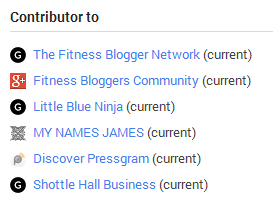
Create a spreadsheet for those prospect bloggers. Include columns for their personal websites, contact emails/forms, Google plus profiles and samples of their works (e.g. at least two guest posts).
2. Evaluation
Filter your list of prospect bloggers based on different quality metrics such as:
- Authority of domains where his guest articles have been published.
- Quality of content produced by the guest blogger (i.e. flow of information, hooks, style, format, etc..)
- Relevancy of the content he creates (targeting general or specific market segment – e.g. SEO is general; link building is specific).
- Strong social following (Twitter and Google Plus following).
These metrics could help you filter out influential bloggers that don’t fit to your A-list prospect bloggers such as those that publish re-hashed articles on their guest blogs, don’t have any strong community/connections (less than 500 social followers) and those that contribute for low quality domains (DA 20 and less).
3. Pitching
Craft your email copy using the same angle you used for the second link building strategy – inviting authoritative guest bloggers.
However there is one main difference between the two approaches – that is, paying guest posts from influential bloggers will focus more on monetary incentives.
Normally, a guest post from an influential blogger will cost from $100 - $250 depending on the goals and metrics used to quality a certain guest post or the domain where the guest post will be published.
This monetary incentive can become part of your email and could help your outreach campaign to get quick responses from your end-receivers.
If you liked this post, you can subscribe to this blog or follow me on Twitter and Google+.
Image Source: 1
Building Organic Backlinks the Right Way
Organic links are often termed as, “natural links” and are considered as votes for the site. These links are products of highly-targeted content or link bait pieces that aim to provide specific value/information to users (i.e. how-to guides).
Link baiting has long been discussed on many SEO blogs and probably because of its popularity and an easier process than creating viral content pieces. Popular link bait pieces is more than just a one-time strategy and if you’re not lucky enough, you would need a year or two see the best results using this link building strategy.
However, unlike any viral content pieces, paid advertising and big budget won’t be necessary in the first time frame of building your link bait assets. You would only need a proper execution of the process to get things done correctly and get you earn high quality organic links.
A lot of the tips that I’ll be sharing below require content assets to execute organic link building effectively.
Link seeding
If you’re doing link building for startups and newly-established blogs, this technique could land you various link opportunities that your competitors may haven’t know about.
The process starts with identifying “long tail queries” that your target audience might be using to find your products, your brand and informational content in your industry.
I personally use KeywordTool.io for this technique for the following reasons (which are also present in the tool page):
- It generates up to 750 suggestions for every keyword (which are mostly long tail queries).
- Best alternative to common keyword research tools like Google Keyword Planner.
- It's absolutely free.
To start with, you can create a list of keywords that your audience is using to find your unique selling point (service, product, blog, etc..). Then discover more topic ideas by grabbing those keywords in KeywordTool.io.
You can simply use your main keyword, e.g. “personal injury” or add words like, “when”, “how” “what” “where” to your main keyword to yield more informational-based long tail queries.
Don’t forget to select your country search when performing this in a local basis.
To populate the list, you can grab discovered phrases and do the same keyword research technique to discover more topics and search queries.
List down all the brand and industry-related keywords and search queries in a spreadsheet and choose only the informational-based keywords to look for link opportunities.
Do a Google search for each of the keyword but be careful when you do continuous search (follow tips in this post to scrape search engines without pissing them off).
Here is a list of link opportunities that can be generated using this keyword-based link strategy:
- Ranking outdated resource pages that need additional information/data/diagrams.
- Forum boards/threads that rank for long tail queries because of the continuous answers/question of members participating on those threads.
- How-to guides that need visual content to better serve the users effectively.
These link targets could give you chances of generating new links for your page/content/site. The more organic links you earn from them, the more referral traffic they can bring to your website.
Conversion link building
Links that help achieve the brand’s conversion goals are more valuable than ordinary referral links. Aside from the fact that they can generate leads/sales, most of this link type is evergreen. Evergreen links are links than tend to last and provide more value to the linking to page/site because those links are placed naturally and strategically and built with conversions intent.
For instance, you can link out to your informational pages from your content distribution pages (i.e. guest post) instead of directly using anchor texts to link to any page of your website. A good example of this is this guest post by Adam Connell at BoostBlogTraffic.
The author byline provides a link pointing to his free guide (ebook).
Linking out to information pages and conversion-captured pages (e.g. where users can stay and subscribe to your email list) could benefit your branding strategy given that you can target two birds with one stone (links and subscribers, links and followers or links and leads).
Make sure that the content you contribute on other authority blogs/sites are topics that are related to your business so that people who can see your informational link can convert into customers/followers/email subscribers.
Another organic link building technique that you can start trying is link building from pages that are highly visible on search results (targeting ready-to-buy queries or conversion-based keywords).
You can use the same keyword research tool earlier and find conversion-based keywords. Add phrase like, “where to buy” or simply add “where” to your main keyword. Identify if the resulted long tail queries can drive conversions to your brand and use them to search for more link opportunities.
Given that the searchers are ready to purchase in this phase of search, earning links from these ranking pages can continuously drive conversions to your website.
Improve your site’s linkability
Improving your site’s linkability would need proper foundation on your website given that if you’re able to fix your site’s technical issues, your tendencies of ranking for industry-related keyword is higher, which can result to more linking opportunities (when bloggers start to reference your content from their sites).
Here are a few technical and content tips to enhance your website’s linkability:
- If you removed your old pages that are still sending traffic and links to your website, you can create new pages that contain the same information as your old pages have. Then redirect old URLs to your newly-created content. Share your new pages on social networks so you’ll have tendency of earning fresh new links and shares.
- Make your most important pages visible on your homepage by including a link to your linkable assets and/or most converting pages or adding image links pointing to those pages.
- Create new resource pages that curate internal and external links (e.g. introducing a beginners’ guide to…). Then build contextual links to these pages through community discussions, guest blogs and/or link outreach to resource pages that are related to your content. You can check out this post on link building using content organization.
- Add appropriate social sharing buttons that your audience is actively using (e.g. Pinterest for photo blogs). You can also add buttons that your target audience might be using to share your content (e.g. Inbound.org share button for online marketing blogs).
Content upgrade
Every content piece from every industry requires continuous improvement or update given that there are always new information/data/analyses that need to be added to provide more value to a particular group of users.
The best way to find pages that need upgrade/update is using link building tools like Outdated Content Finder, Screaming Frog and Open Site Explorer.
OSE has its new feature where you can filter the top pages by http status. This could give you provide you more information on which links are broken but are still sending relevant traffic to the site.
Do a reverse engineer to your competitors’ websites and non-competing websites that have the same brand attributes. Grab one URL to OSE, filter the Top Pages by 4xx. Do the same to all of your competitors. Then create a list of all the broken links your competitors’ sites have.
To see if those dead pages are good opportunities to upgrade, you can use Archive.org or any tools that can bring you back to the history of those pages. Identify if the lost information of those pages is relevant to your brand and can easily be your team’s expertise.
Create a content that is comprehensive and engaging to the users, surpassing the old information found on the broken pages. Make it more interesting by investing design formats (images, slide decks, videos) to it.
Reach out to the people who linked to your competitors’ dead pages and asked if they can mention your new content in replace for the broken link. Generate more organic backlinks by including your new content on community discussions/forums, Q&A sections and social media groups.
More Resources:
Creating and Developing Content Assets Like A Pro
Strategic content distribution
Distributing your content on other related blogs (i.e. guest posts) could provide you more than one link. Here are a few tips to maximize the value of your content distributed pieces:
- Aim to provide unexpected hooks to your guest contributions given that the more people are consuming your content, the higher are the tendencies that your piece can attract more shares which will later on turn into organic links.
- Exceed the expectations of your guest blog target by providing useful information that no one in your industry has published on. This could give you an opportunity to be featured in the top contributors page which is good not only to build more internal links to your distributed content but to brand you as an author within that specific niche. You can check out this post on how to guest post strategically on other relevant blogs.
- Target content-focused websites that are authoritative in a very specific industry you’re targeting. The more closely related the site is, the better, since you can easily drive conversions from those content distributing sites.
Use SEMRush to find guest blog targets that are content authority in your industry. When they increase their rankings/search traffic after the recent Panda update, it means that they have proven their content authority in a particular niche. If you target them for content distribution, you’ll benefit more value from those sites in terms of link building, conversions, and social sharing.
Target long tail keywords in your content distribution pieces like in your slide presentations. If these pieces happen to rank for those keywords, it can generate new users to see, consume and even include your pieces from their blogs.
You can also track those followers who’ve shared your slide decks on their websites. Ask if they can also link to your website as the source of the information. You can even get higher conversion when you create a page designed for all the slide presentations, webinars and videos you’ve recorded/uploaded both on and offline.
Interaction Link Building
Building relationships with your customers/followers/brand loyalists could bring a long way to the branding of your website. It is also the easiest way to understand your audience’ needs and let them contribute insights to your content creation.
Add a quick survey on the blog section of your website, asking which topics they would want to see on your site. You can also ask questions regarding the content format, length of content and other content elements to generate more feedbacks from them.
The more targeted and useful to a specific persona group, the higher is the likelihood of earning the trust of your target audience which eventually will bring organic backlinks to your website.
Email your customers using a personalized email copy to inform them about your new product features. A simple email template with no ads, images, videos and attached are more likely to convert to new feedbacks and sales.
Email from Positionly
Create alerts from Q&A sites like Quora to get updated with timely questions that you can immediately answer in a daily/regular basis (use IFTTT).
Those questions can also be the main topics of your content, which can help you rank for several long tail keywords given that the topics might be the exact keywords users are searching for in Google.
Final Thoughts:
Organic link building considers great content to passively and actively acquire relevant and high quality links. By using the above actionable tips, you can generate fresh new content and links to your brand/site.
If you want to conduct an organic link building campaign, you can contact us for link building services quotes.
Image Credit: 1












